
The Ultimate Guide To Things To See In Gdansk
Walking into Gdansk was like walking into an old Wilhem Grimm fable. As you step off the train you are greeted by an old red brick building with flourishing facades that will start to tickle your imagination. As you wind your way into the heart of Gdansk Old town you feel as if you should be dressed in a renaissance outfit to fit into your surroundings. There are so many unique things to see in Gdansk starting at Długa Street, site of the Old Market Square, you will pass through the historic gates of the city, visiting Arthur’s Court, Neptune Fountain, the Old Crane, and 15th-century Basilica of St Mary’s.
Besides these top attractions in Gdansk, there is a history here that many people throughout the world do not know. Before I get ahead of myself, there are a few things you should know before visiting Gdansk.
Click on any section in the table of contents and it will help you jump right to that spot :) Wanted to make it as user friendly as I could ;)
Quick Facts On Gdansk
Is Gdansk crowded? This is a major city in Poland that is frequented by cruise ships as it lies right on the Baltic Sea, so it can get crowded at times.
How to get to Gdansk? There is a major airport here, and is easily accessed via Eurail from Berlin. There are ferry's that do connect Sweden to Gdansk as well.
When is the best time to visit? June is the best time to visit Gdansk because of the long days and low rainfall. The high season for Gdansk is July and August. May to September weather ranges from Max 52-72 F (11-22 C) to Min 37-55 F (3-13 C) so dress accordingly.Are there beaches in Gdansk? Gdansk does have a beach, but I would recommend bringing a short wetsuit as the waters can still be quite cold.
Can You Scuba Dive in Gdansk? There is Scuba diving available, it is mostly wreck diving, and the best wrecks to dive are in Zatoka Gdanska.
What is Gdansk Known for? Gdansk is considered to be a symbolic place of the Second World War, not just for Poland but for the whole world. Many people believe this is where WWII started.
What is the Tipping Policy in Gdansk? Tipping restaurants, and bar tenders 10-15% is common and expected. Tipping a taxi driver is more of a 'give what you can' but is not necessarily expected. Please remember to tip tour guides and the tour drivers.
Safety in Gdansk? It is illegal to drink from an open container in public and you can get a ticket. Emergency numbers: 112 for Police, 999 for Ambulance, 998 or Fire. Overall I felt VERY safe in Gdansk and was not as worried about pickpockets like I would be in Italy and France, however, I would still take the usual safety precautions that you would take in your own home town.
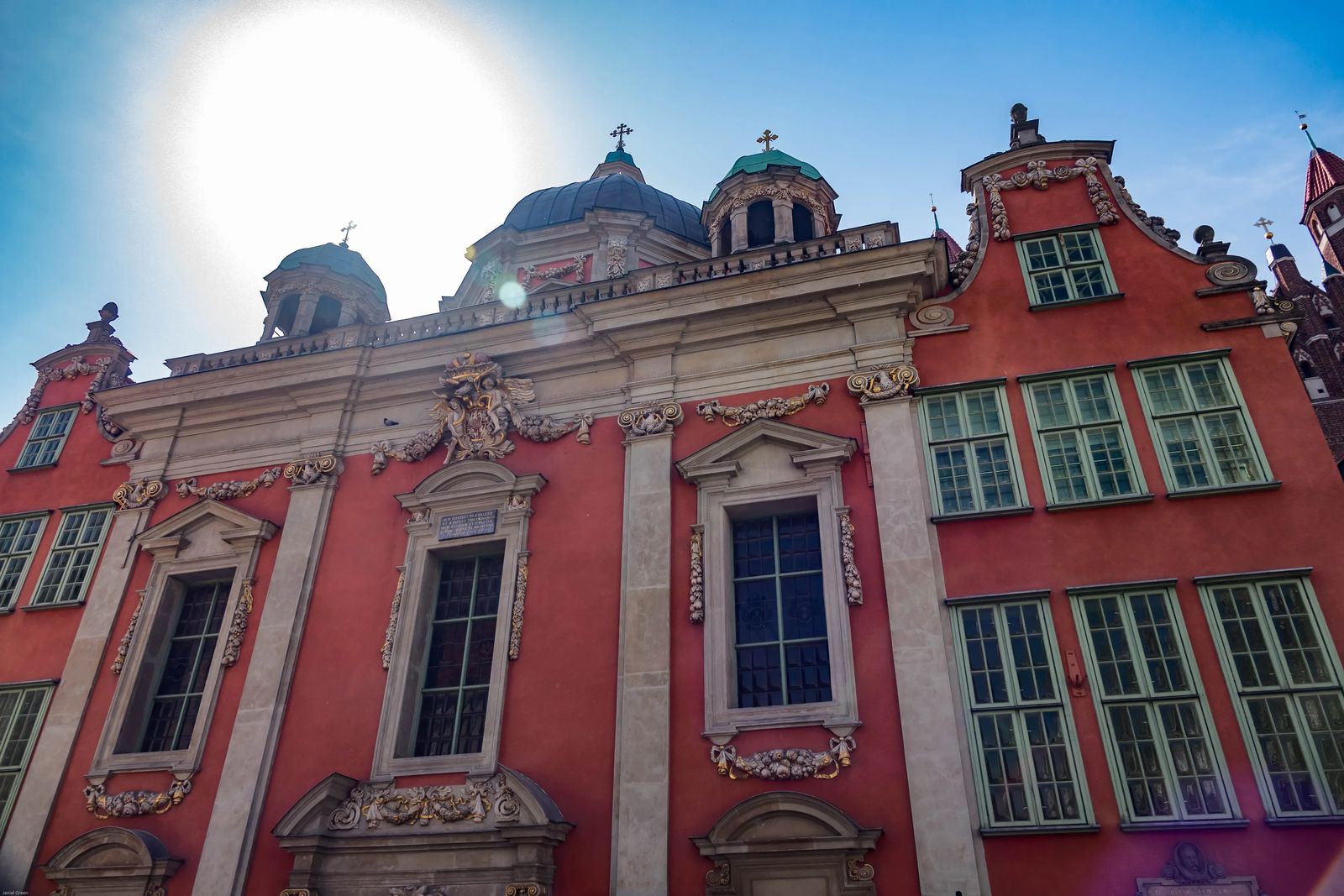
History of Gdansk
I think if people knew the amazing history of Gdansk they would realize it is a city that is well worth visiting. Knowing a bit of the history also allows for you to discover more meaning behind the destination - instead of taking a picture to post on social media.
Gdansk is one of the oldest cities in Poland, first being mentioned in the Polish diocese of Wloclawek in 997. By 1308 it was a major trade city and attracted the Teutonic Knights attention who seized the city. The Teutonic Knights were a religious group based out of Germany that often oppressively converted pagans in the region to Christianity.
The city was regained by King Casimire IV in 1466 after a 13-year war, after which it bacame the most prosperous city trading port in the Baltic Sea. At the height of the trade in Gdansk, they were exporting 200,000 tones of grain each year. Shipbuilding became a major part of Gdansk, and the first warship launched in 1572. The shipbuilders union will play an important role in the 19th century history with the creation of the Solidarity union.
The 17th century brought the Swedish wars, then Prussia seizing the city, after which Napolean I freed the city - and then was reunified back to Prussia. The 19th century came along and the Treaty of Versailles allowed Poland to govern it again.
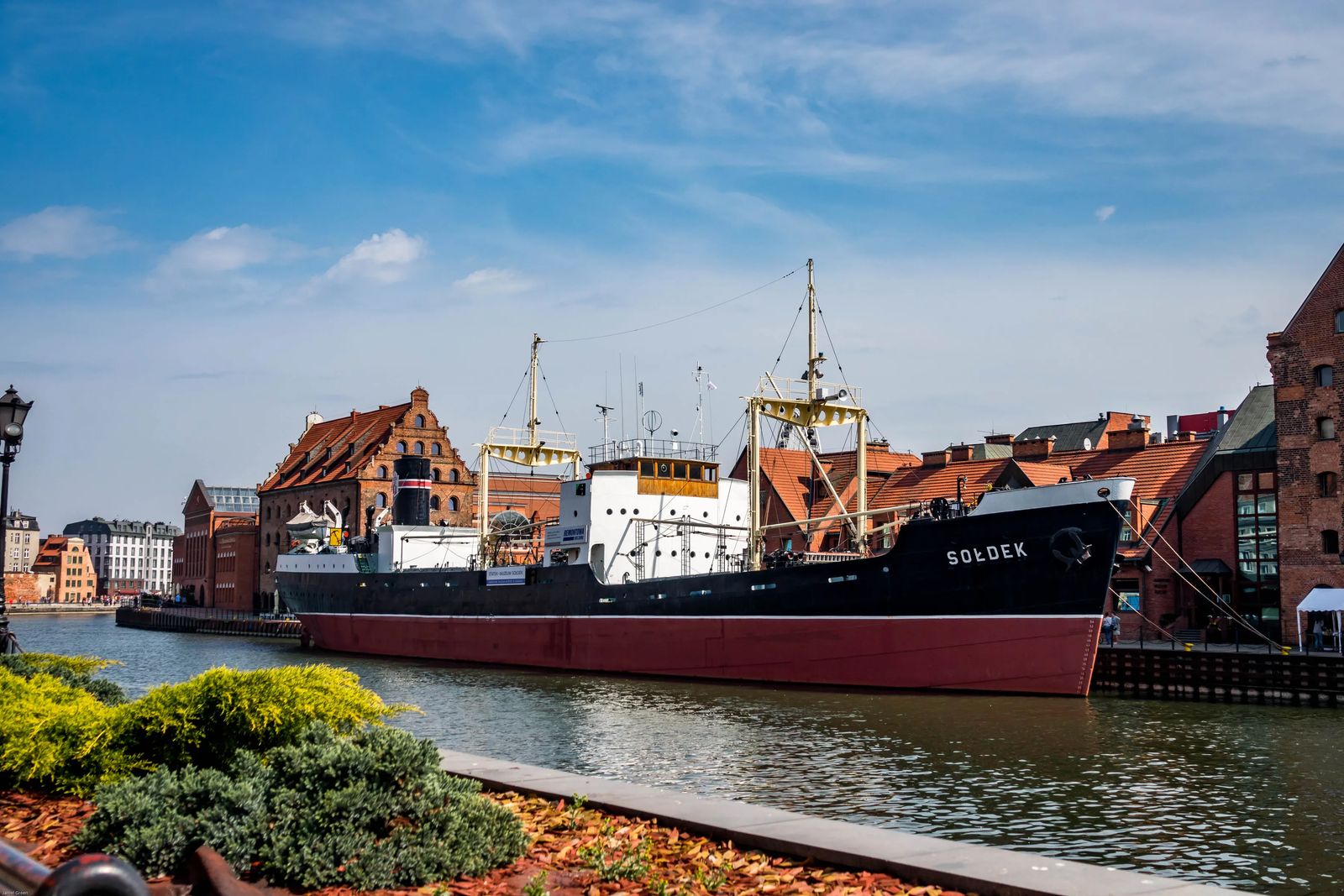
Fast forward to 1933 when Germany National Socialist (Nazi) Party won the elections. Adlof Hitler demanded that Gdansk be given to Germany. Poland refused, not wanting a major port and trading city to fall into the hands of a dictator. Adolf Hitler took this as a personal affront, and took it as a provocation of Poland against Germany. He attacked on September 1 1939, thus beginning the start of WWII. There is a memorial on Westerplatte Penninsula commemorating servicemen who fought there in the first battle of WWII in September of 1939. These brave service members withstood horrific bombardment of the Germans for seven days before they surrendered. (I will talk about the heroics of the Polish Civilian Post Office Employees below).
It was a long and bloody war, with 6 million Polish citizens dying, many of them imprisoned and tortured in Aushwitz and Berkenau. Gdansk was virtually leveled 90% of the city during the war and Gdansk was finally returned to Poland in March of 1945. Reconstruction of the city was a massive undertaking, and great care was taken in recreating Gdansk to its former glory. Much of the city has been restored to its ideal pre-1793 state with any traces of German architecture and traditions largely ignored, understandable given what they had just been through.
In the 1970's there were large anti-government demonstrations against the communist leader Wladyslaw Gomulka. The birth of the Solidarity trade union movement took root, men, women, and children were enlisted. It was a force of nearly 10 million who demanded social freedom. Martial law slammed down on the recovering WWII citizens of Gdansk in December of 1981. The movement moved underground and after 8 years of resistance, there was finally a round table meeting, where a peaceful exit of the communist system was agreed upon.
The success of this solidarity movement allowed Poland to regain full sovereignty. Poland is still regaining its footing in building a democracy and radical free market.....but the continuous revival and resilience of the Polish people is one I will certainly never forget learning about. In fact, I would venture to say, this city is one of the most hopeful and inspiring places I have ever visited.
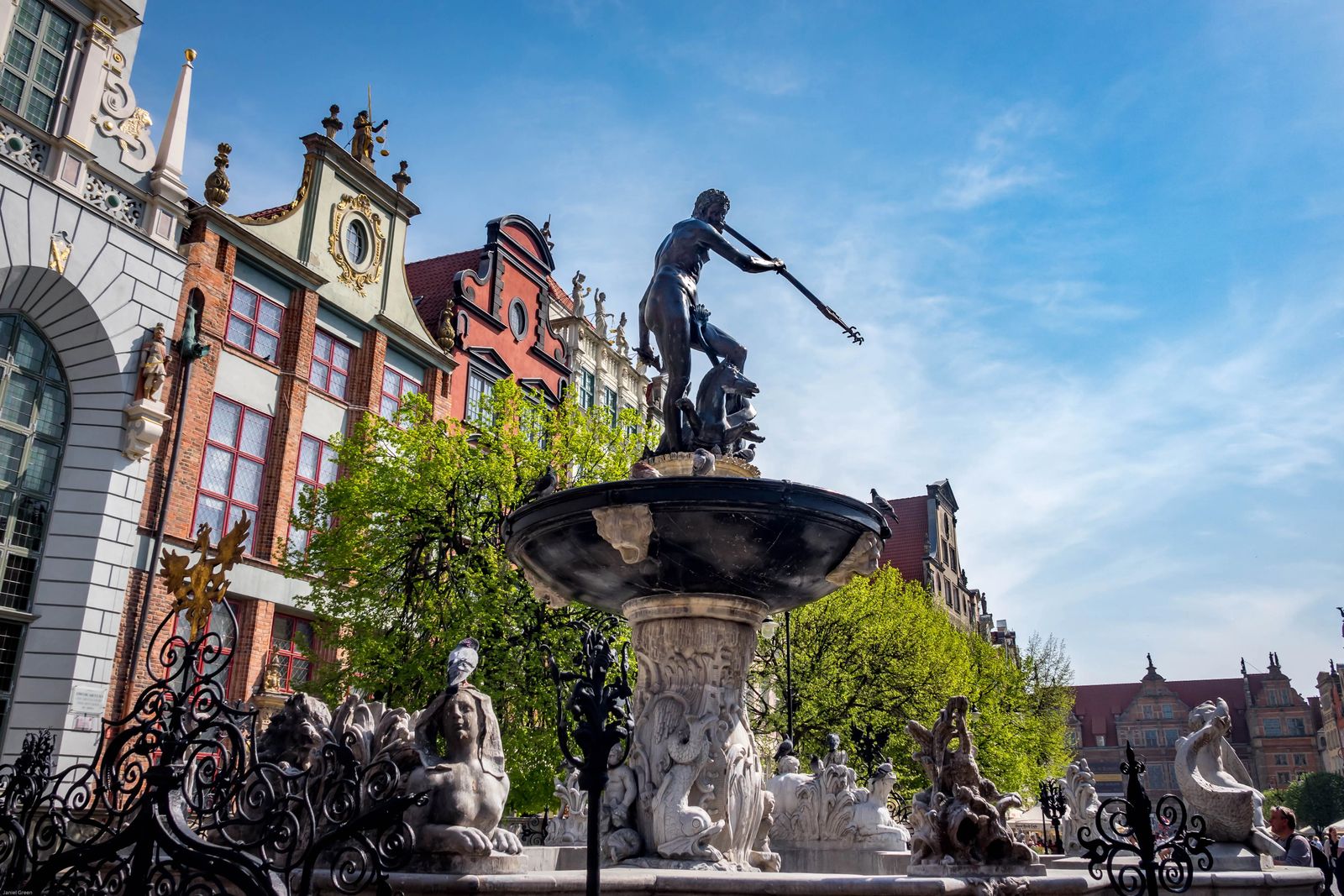
Neptune Fountain (Neptone Fontana)
Address: Długi Targ, 80-833 Gdańsk, Poland
This massive 1433 lb (650kg) fountain is one of the most photographed spots in Gdansk. It has been a pivotal landmark for the people and for celebrations of the city since 1633. It is located in Long Market, and is quite stunning at night as the fountain and the surrounding 17th century square are lit up like the days of old.
Unlike the days of old though, the fountain no longer holds the golden flakes and Goldwasser it once did. Goldwasser is a Gdansk liquer infusion that, according to legend, poured out of Neptunes trident one night and he was suddenly surrounded by hoards of drunken locals who were literally drinking golden flakes. There is another version of the story, where Neptune was so agitated with the druken locals using his fountain as a place to toss their coins that he hit the water with his trident and broke the coins into golden flakes.
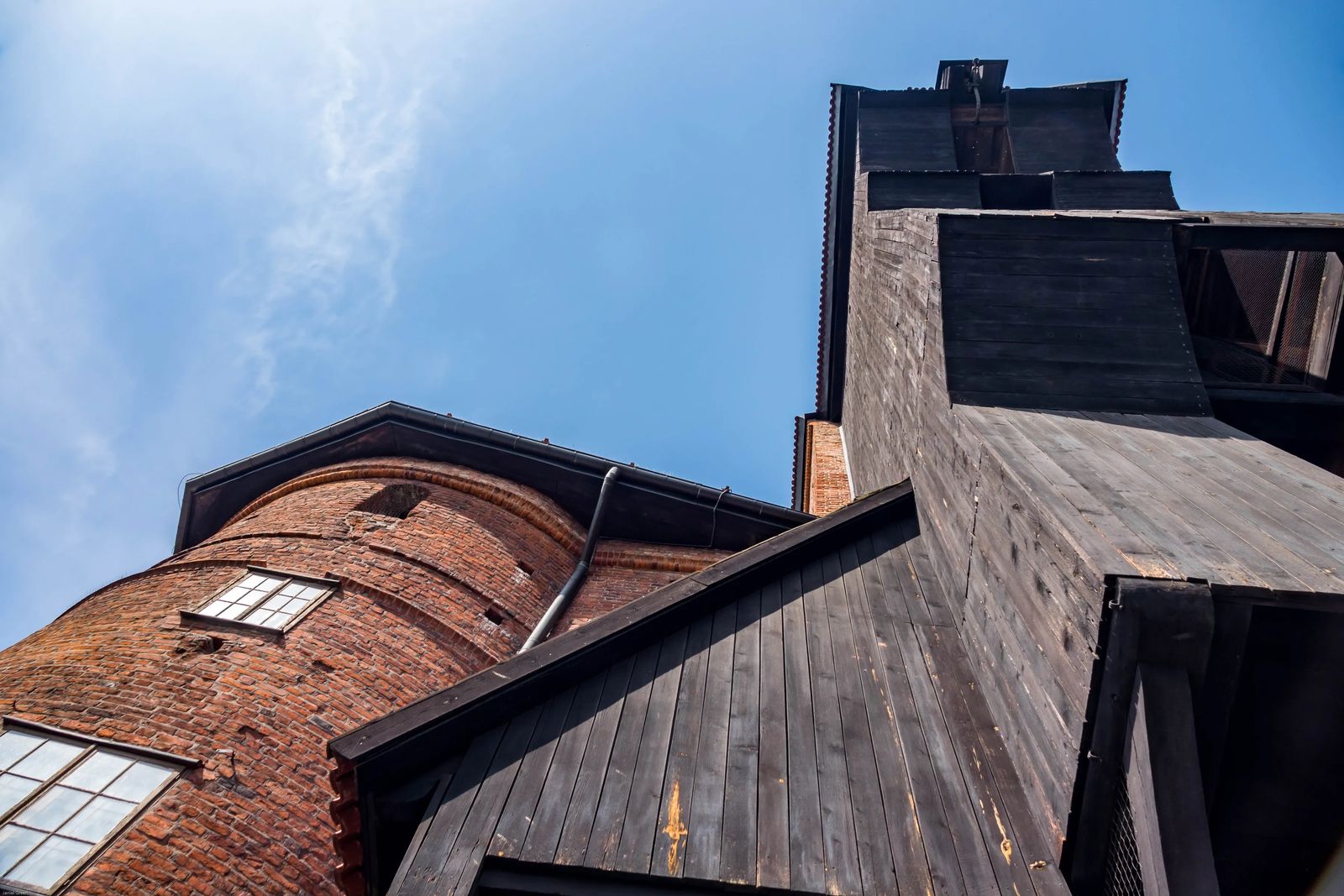
The Crane (Żuraw)
Address: Szeroka 67/68, 80-835 Gdańsk, Poland
History books first mention this crane in 1367 and was used as more than just a crane - it was also used as a pivotal gate into the city. Until it burnt down in 1442, then it was upgraded to to brick towers with a wooden with a wooden lifting mechanism installed in between.
The crane was used for helping to haul large loads of grain and other exports into and out of the ships coming into the harbor. There is a museum that you can see the type of economics that helped this city grow into something so coveted by the surrounding countries. You will also see the ingenious design of the crane where humans were used, on treadmills to help haul and lift things into and out of the ships. There is one of these treadmills visible from the road underneath the crane, and another on the upper rafters (stair climbing required) with gorgeous views of the Motlawa River from the Baltic Sea.
The Crane’s last master engineer died in 1858, and its towers were occupied by residents of the city. A shoe manufacturing business, a hairdresser’s salon as well as other local businesses were set up within its walls.
An adult ticket costs 8 PLN. Tickets can be bought in Osrodek Kultury Morskiej museum (maritime museum). Wednesdays are free of charge. Zuraw is closed on Mondays in low season.

Pirate Ferry on the Black Pearl
Address: Prom pasażerski Motława, 80-001 Gdańsk, Poland
This is a great activity for kids in Gdansk. While it is a tourist trap, it does provide a fun place for kids to explore what it would be like to be a pirate on a ship in the 17th century. If you look at reviews of it by the adults, the reviews are not favorable at all. There are very few places to sit on board and they do round trip tickets for a reasonable price. The boat travels from just past the crane to Westerplatte. Once in Westerplatte, you exit the ship and are left to your own devices. Check the times to make sure you can still get the boat back if you are staying near the Gdansk crane.
I personally didn't take the boat tour, as most adults boarding it looked bored and surly. The kids were ecstatic to be on Jack Sparrows Black Pearl ship though.
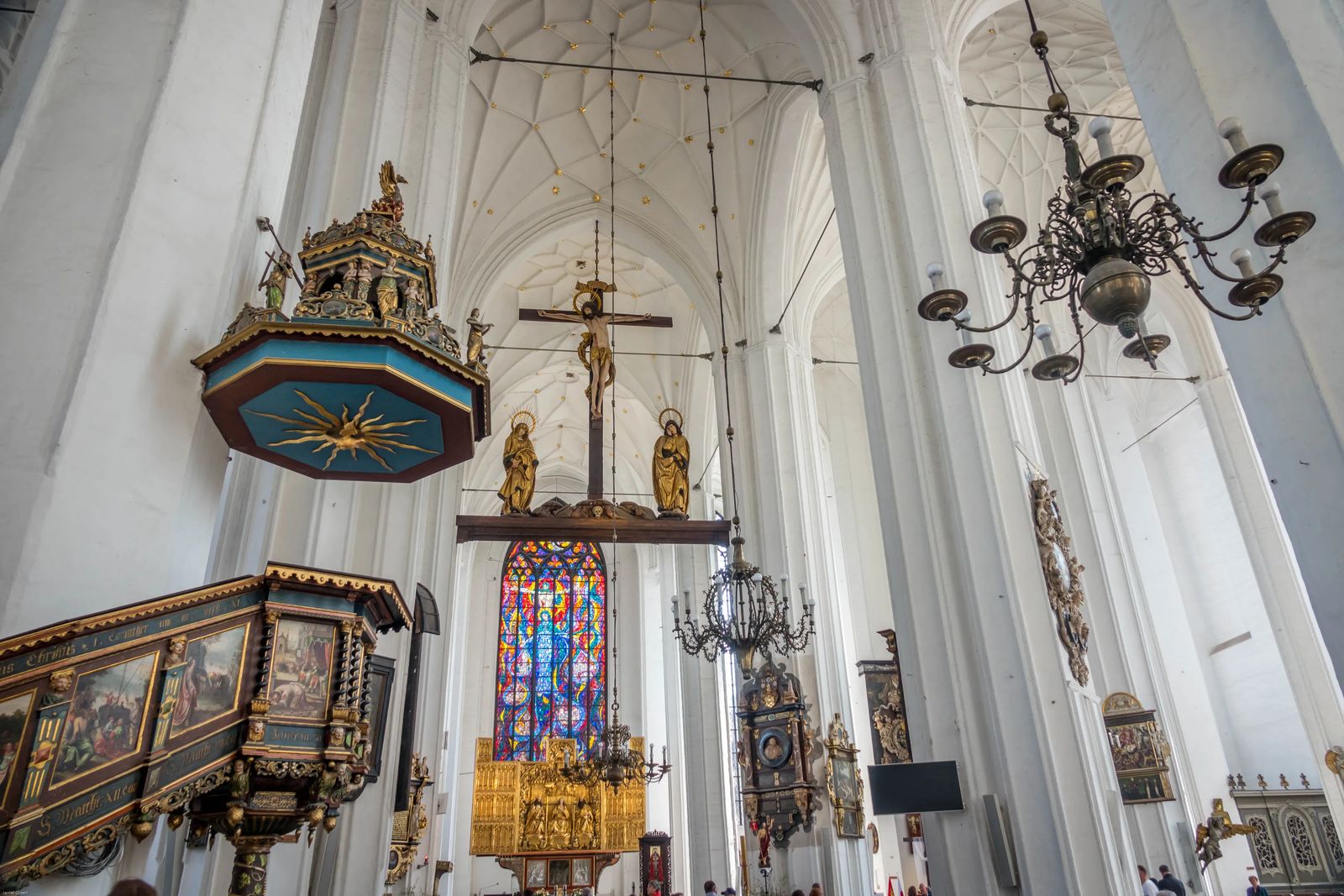
St. Mary's Basilica (Bazylika Mariacka)
Address: Podkramarska 5, 80-834 Gdańsk, Poland
The tower of St Mary's Basilica is nearly 256 feet (78 meters) high, and has a claim of being one of the tallest red brick churches in Europe. It was built in 1343 and over time has changed from Roman Catholic to Presbyterian so the only place you will find Frescos on the walls are in the right front corner.
This is one of my favorite churches in Europe, when you walk in, you almost feel like an ant walking into the waiting chamber of heaven. The massive columns soaring above you into gothic arches that appear as if they are lattice work about to burst through the ceiling into the heavens above.
If you want to see how it is to nearly touch heaven, or at least get an incredible panoramic view of Gdansk - then try climbing the 405 stairs to the top of the tower.
Once you come back down to earth, be sure to head over to the Astronomical clock. One of the first clocks in Europe. This was built in 1470 by Hans Düringer and is 46 feet high (14 meters). If you wait until 11:55am then there is an 8-minute long show when the clock goes off. Figures dance in and out of the wall, prancing about on their tracks displaying religious events with accompanying music.
Tickets to the tower costs 6 PLN ($1.40) so if you have the quads and knees to do so, I highly recommend getting a view of this beautifully rebuilt city.
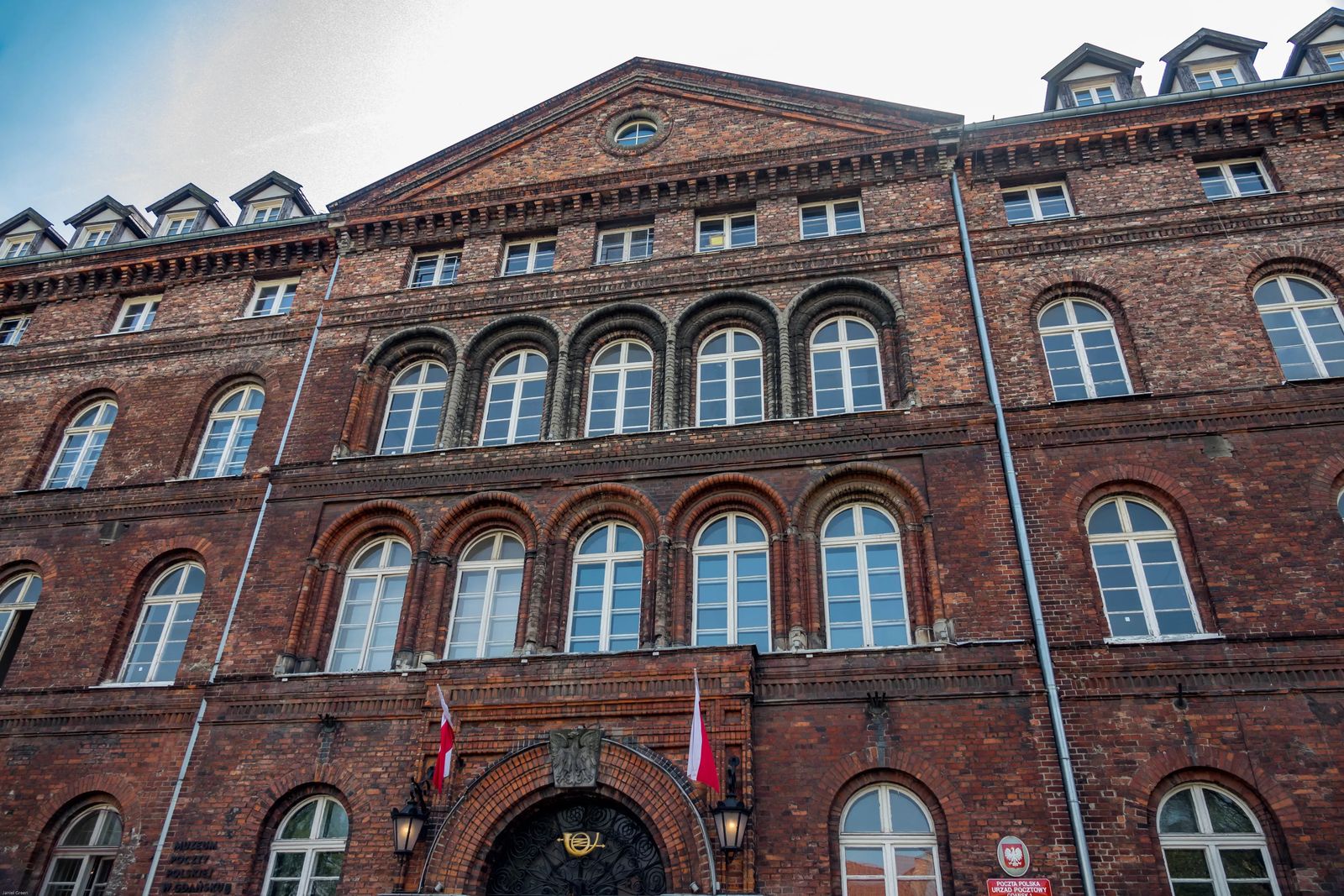
Memorial to Postmen
Address: plac Obrońców Poczty Polskiej 1/2, 80-800 Gdańsk, Poland
While the Westerplatte is considered the beginning of WWII for Poland, about the same time in the early hours of September 1st the Polish Post Office was fighting its own monumental battle.
Postmen awarded highest honorary cross for standing up to the Germans. There is a wall with fingerprints of the postmen with a few of the children as well. After months of the mailboxes marked with the white eagle, symbolizing Polish pride, being defaced. The white eagle was scraped off, abusive language was put on the boxes, as well as German symbols. Each of the ten boxes around the city were repainted every morning with the symbol of freedom of the White Eagle.
After months of abuse, the violence escalated to local thugs being hired to beat up the postmen. In 1939 the postal service workers realized they would soon be under attack. They also realized they were the last line of defense for the information about the citizens, their affiliations, connections and so much more from falling into the hands of the German Gestapo and Army.
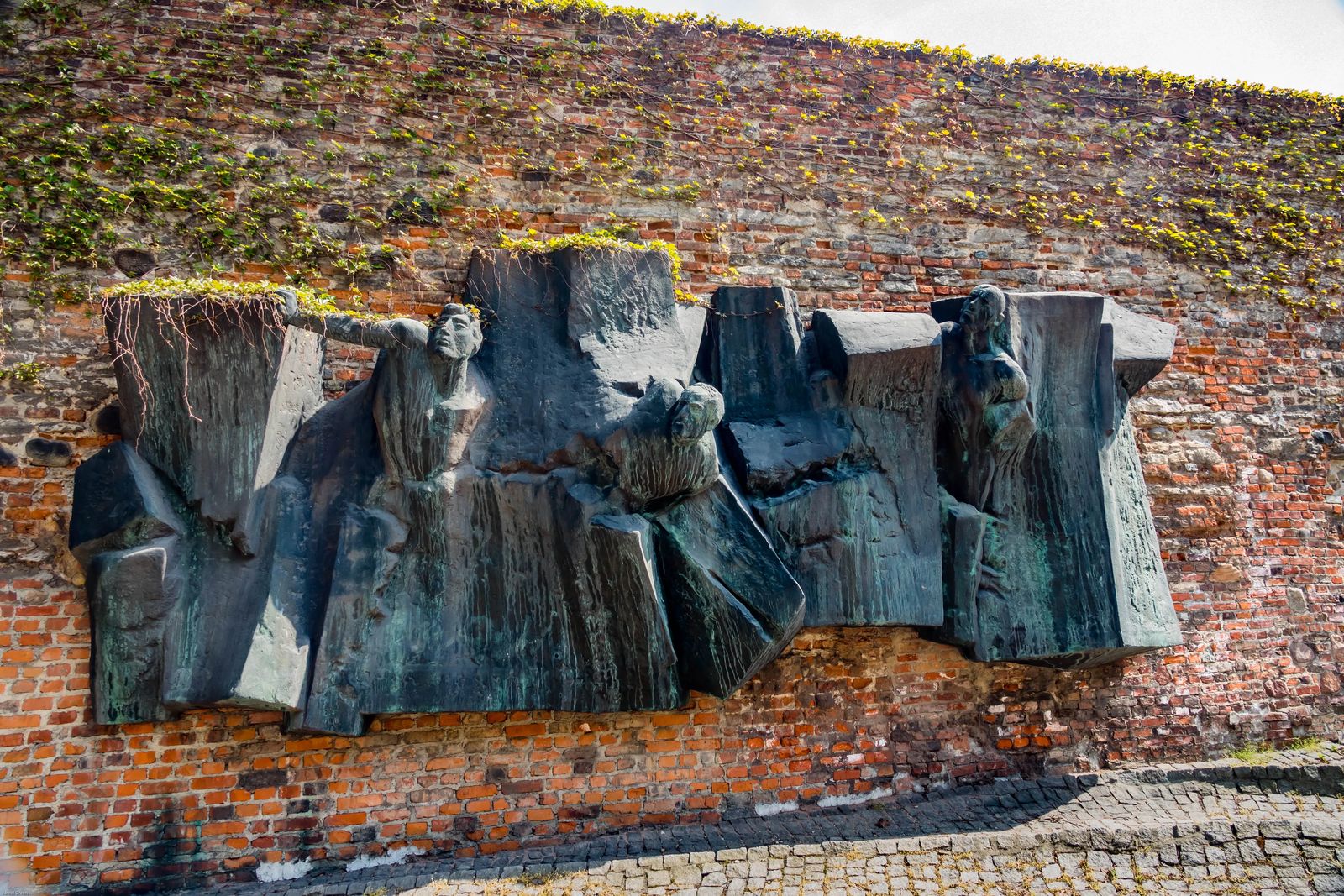
A small group of postal workers defended the post office in the Nazi-controlled Free City of Danzig for 14 hours waiting for help from the Polish Army that never came. They were vastly outnumbered, and the postal service was the last freedom that the Polish who still resided in Gdansk could do without prying eyes or control of the Nazis.
The Polish citizens that still remained in the city were only 4% of the population, but were allowed to the right to run the railways, post offices, schools, and transit warehouses in Westerplatte. The Postal servicemen took pride in the duty and with their distinctive green uniforms were a symbol of freedom to the community.
Under the direction of an experienced Polish officer, Konrad Guderski, the Polish postal service members underwent military training. Reserve soldiers from Gdynia and Bydogszcz came to help and often were hidden in the Polish Post Office. The German plan of attack was leaked, and word reached the post office that 150 Nazi's would be storming the post office simultaneously at all levels in a quick strike to overwhelm the postal service members and gain control of the symbol of Polish freedom.
Help from the Polish Army was immediately sent for, with the plan being to defend the post office for six hours until re-enforcements could arrive from Pomerania. The Polish Postal workers did not realize, is the entire country of Poland was soon to be invaded by Germany on the whole. At the last minute, without word to the Postal Service members, the re-enforcements were pulled back and sent deeper into Poland to protect the capitol.

These brave men, including a few children a postal member was watching for a time for a neighbor - held off the German attack for 14 hours. The youngest child was 11-years old, Erwina. They knew they were going to lose and help would never come, so they hunkered down in the basement. Pumps were brought in, and the basement was flooded with gas, and flame throwers were used to light the basement on fire at 6pm that evening.
The postal servicemen were wounded, cut off from any word of aid, they were running out of ammunition, no water, no electricity and now were suffocating from smoke. A white towel was found, tied to a stick and raised about the head of post office directors head Jan Michon and he walked out of the Post Office to surrender. He was shot immediately by the Nazi's with barely more than a few verbal taunts.
A Polish Army reserve member attempted to surrender and was lit on fire by a flame thrower. The caretaker, the 11-year old Erwina attempted to surrender and all were killed - the most brutal being Erwina who was lit on fire and allowed to run around the courtyard in flames. Erwina unfortunately didn't die from being lit on fire, she was taken to the hospital and suffered for seven weeks untreated until she died alone in the hospital.
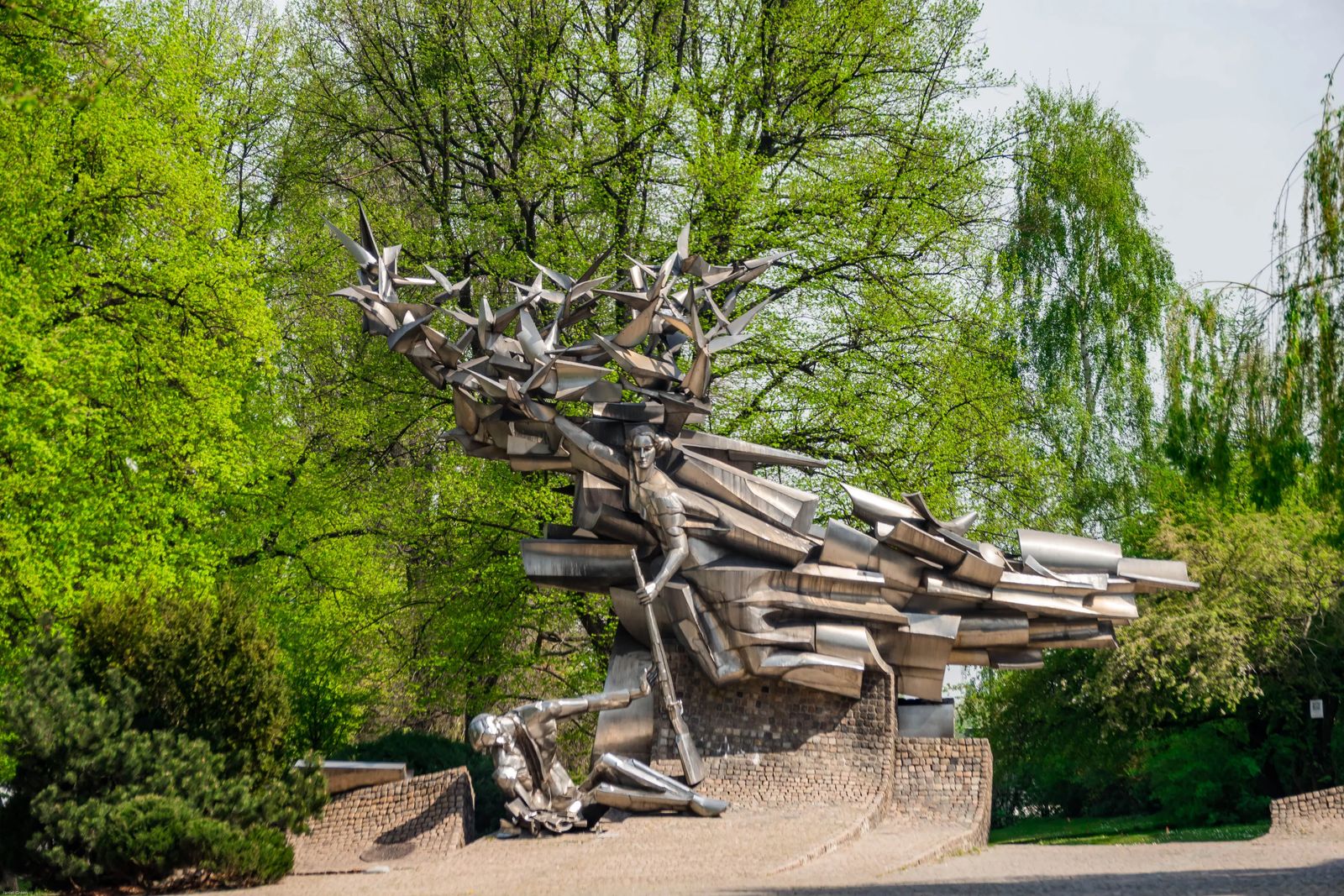
Of the nearly 60 postmen and recruits, the standoff ended with 8 postmen dying in the battle, four managed to escape and survive the war, 16 wounded postmen were sent to the Gestapo hospital (including Erwina). These 16 postmen were sent to Victoriashule where they were interrogated and tortured. The information the Nazi's obtained led to 300-400 Polish citizens being arrested and sent with the postmen to Victoriashule. In September the postmen were found guilty (by a German court), and sentenced to death by firing squad (recreated fingerprints against a brick wall of where they were were killed). The victims were put in an unmarked grave, that was only just found in 1991 near te Gdansk Airport.
The monument outside the Gdansk Post Office is a memorial to the bravery of these Postal Service men, woman and child who withstood the German Secret Service for nearly an entire day.
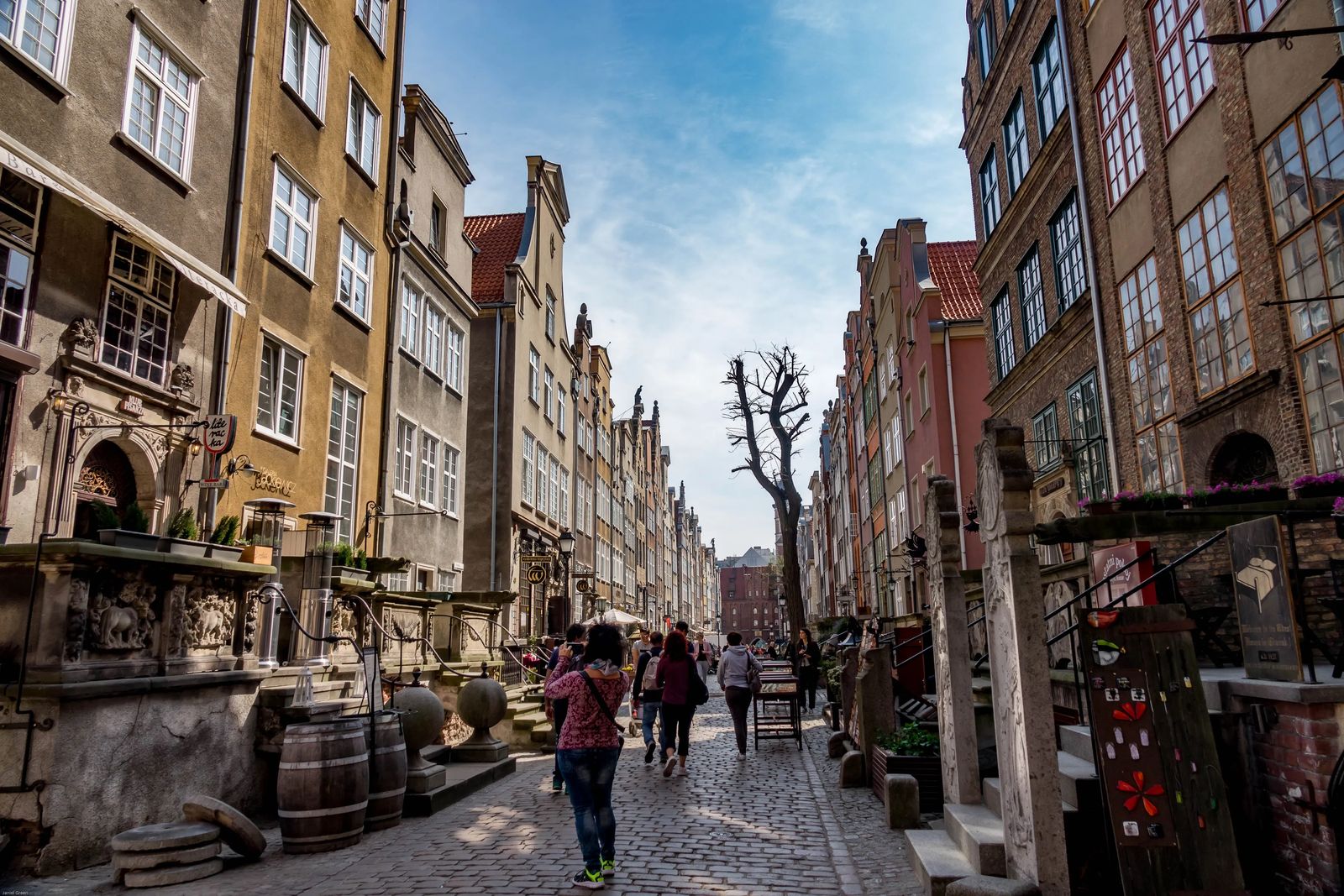
St Mary's Street (Ulica Mariacka) and Sweet Treats
St Marys Address: Grząska, 80-833 Gdańsk, Poland
Stara Pączkarnia Address: Plac Dominikański 1, 80-844 Gdańsk, Poland
St Mary's street is a unique cultural space to Gdansk, where citizens would sit on their patios right outside their home in their fancy dresses and clothes in the 17th century drinking tea. It was like Instagram in the old days - people would show off, gossip and stare at each other with envy but not leave their homes.
After appreciating the beautiful facade of the 17th century homes, head over to Stara Pączkarnia. This is one of the most famous doughnut shops in Gdnask. Feast not just your eyes on the city, but taste this delicious doughnut filled with the finest creme filling in the world. I am always an advocate for desert before dinner, especially when I'm traveling ;)
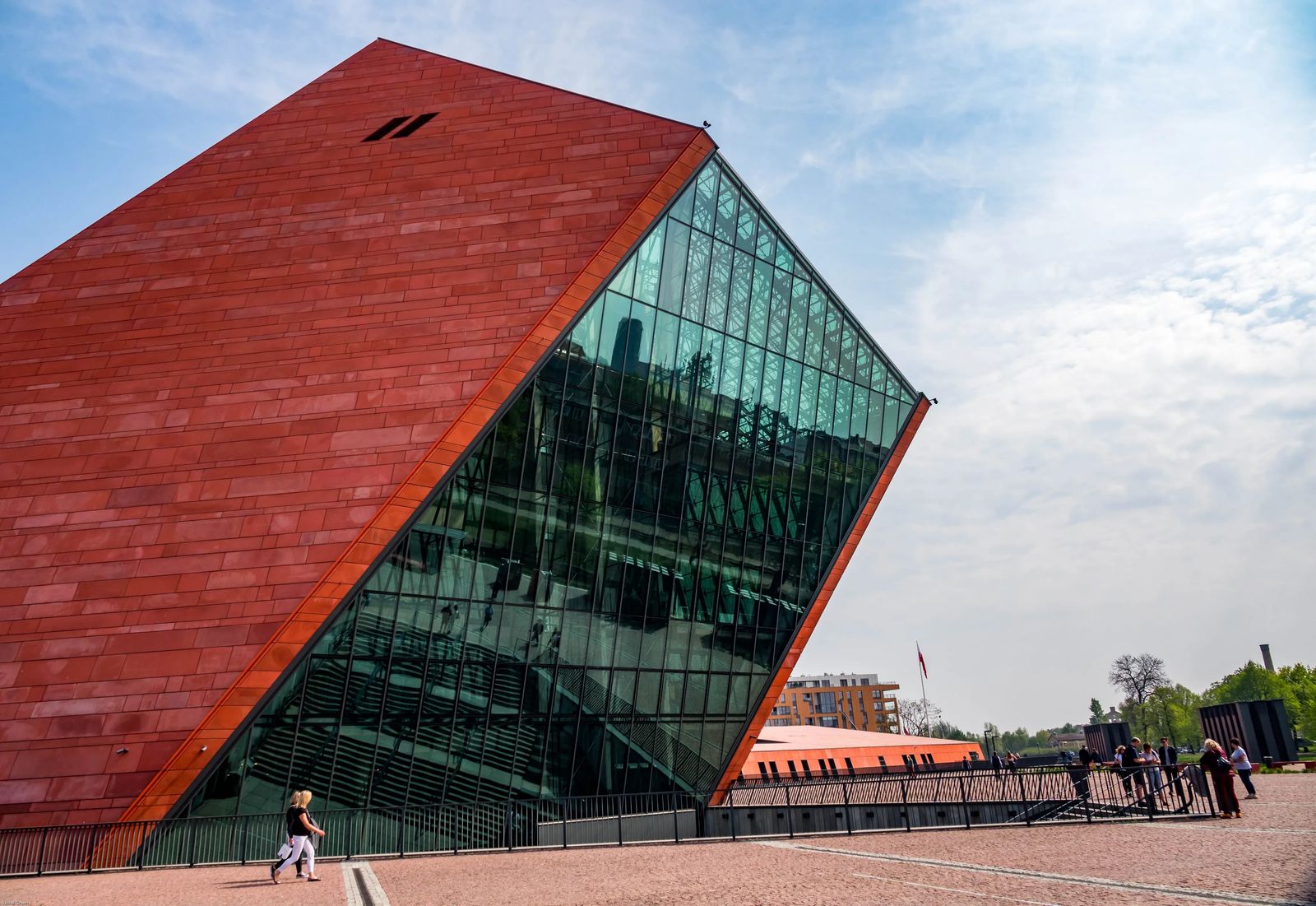
Museum Of The Second World War
Address: Plac, Władysława Bartoszewskiego 1, 80-862 Gdańsk, Poland
This is one of the largest museums in the world dedicated to WWII. The museum is underground and the entire complex has so much symbolism. The building entrance appears as a falling building, with just a shell of brick walls supporting the glass between the reflects the sky. This is the impression I first had when seeing the building, but the architects actually said they wanted it to symbolize a futuristic building pointing to the future. So maybe it symbolizes both, both a memoir to the past, and a way to the future.
The museum itself is 45 feet (14 m) underground and has nearly 54,000 sq ft (5000 sq m) of space filled with WWII artifacts.
This article on Gdansk is massively long already, so I will address what is housed within this museum in a separate article so you don't have information overload. Suffice it to say, this is a MUST SEE for anyone and everyone visiting Poland. I think it perfectly lays out how much Poland and its citizens truly went through. It shows the different tactics that the Germans used to slowly take away freedoms, suppress and finally invade.
There is a re-created Jewish ghetto block complete with a WWII tank inside. There is an entire wall of luggage that was taken from the Jewish people entering Auschwitz. It also contains the bust of Hitler himself, and his gravestone (It was hard for me to not want to spit on it or smash the thing to pieces). It is important to remember the past, so as citizens of many different countries you can help defend people who it may happen to in the future & help put a stop to it before it starts.
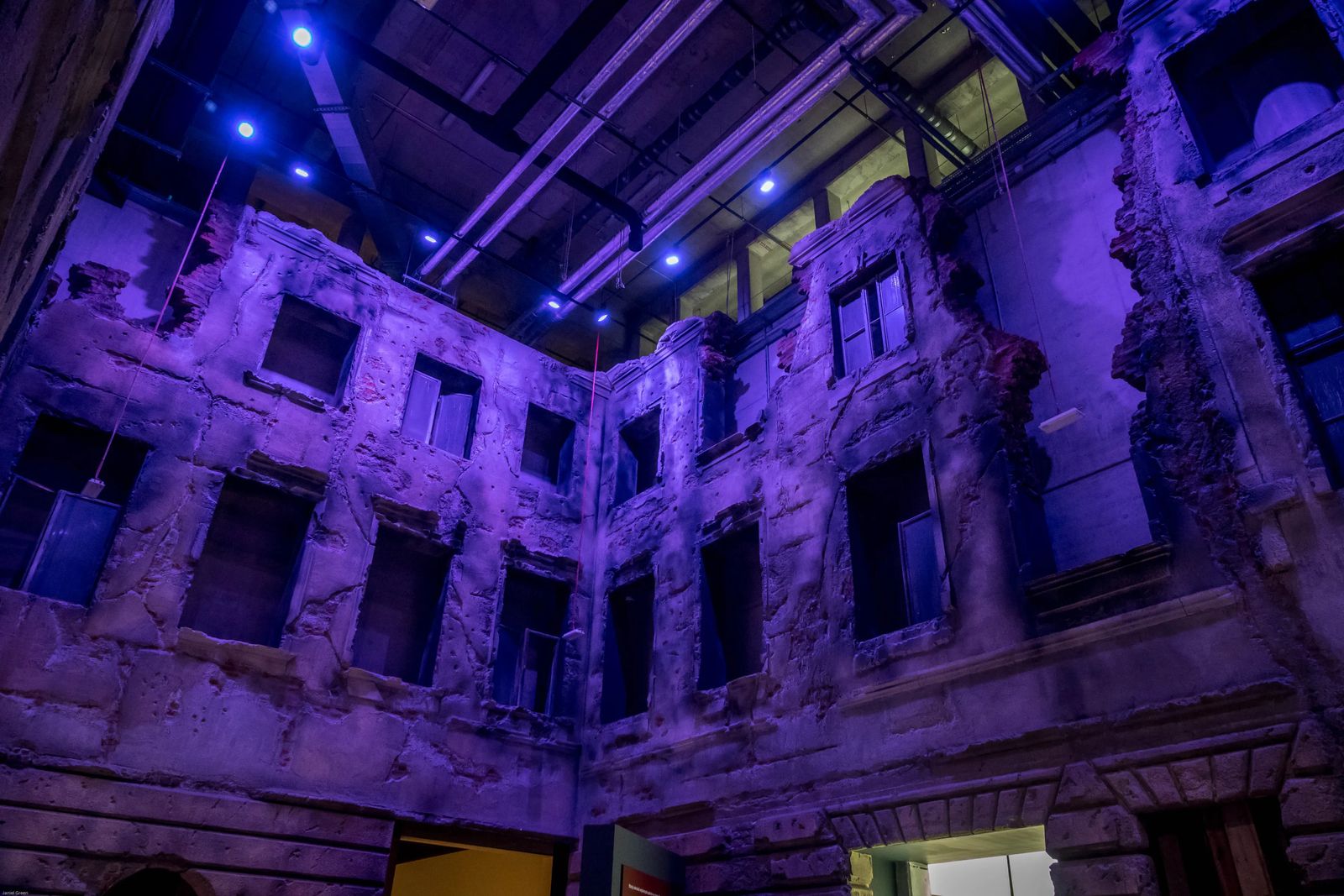
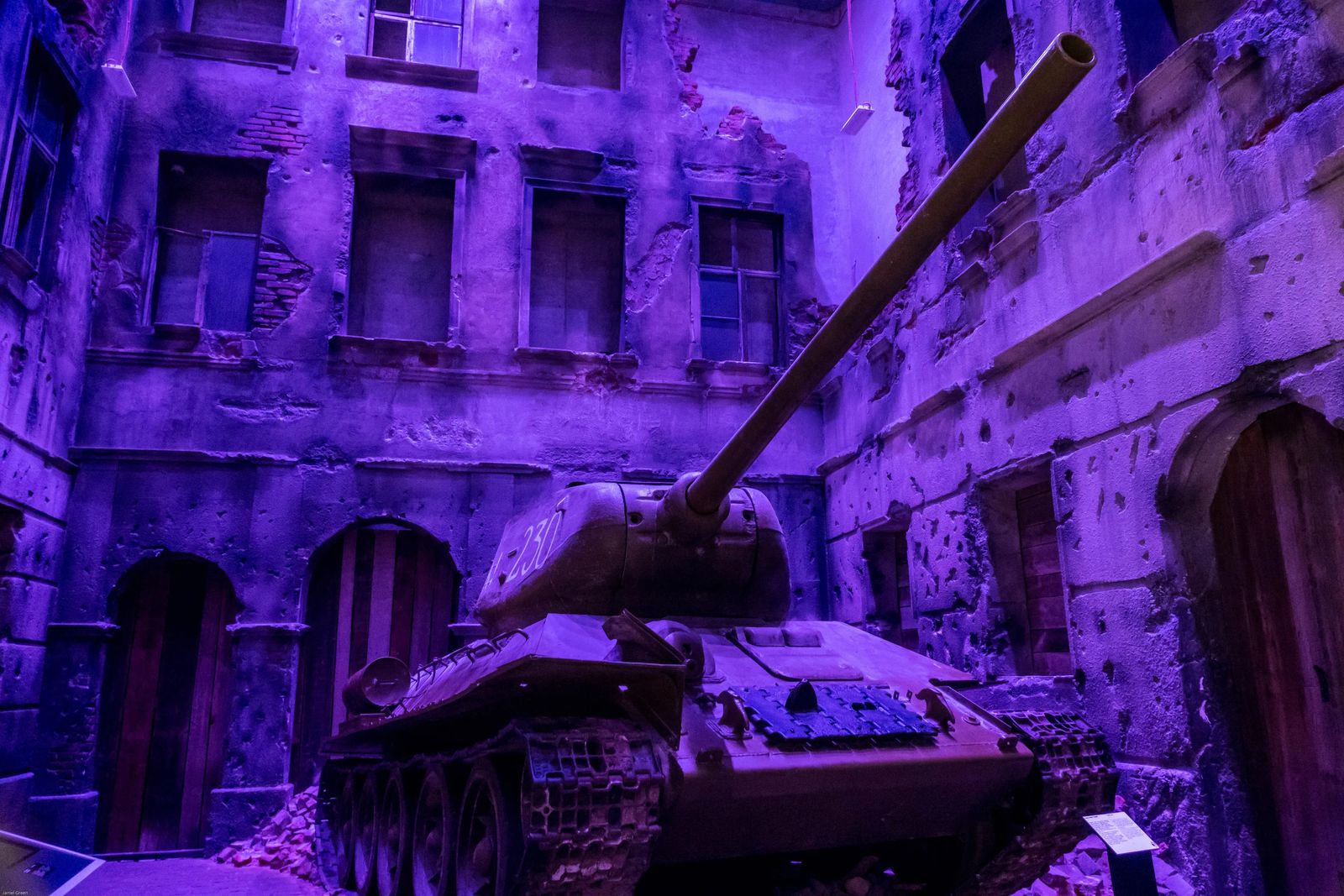
I wouldn't recommend taking children to this Museum personally, I think it is better suited for children 16 and above who can handle emotionally disturbing messages of human suffering. They do have an audio tour for 12 and up, as well as adult audio tours - but I would rate this a PG-13 museum at least.
Make sure you get an audio tour (5 PLN), or if your budget allows I would hire a tour guide. You can arrange for the tour beforehand with the museum, and then skip the long lines that tend to plague the museum. Be sure to visit the main attractions: Reconstruction of the street from the 1930's with hired actors showing daily life, Tanks, bombs, guns, military planes, an Enigma cipher machine, Joseph Stalin's pipe, propaganda posters, and a collection of original letters written during and shortly after the war that will have you in tears by the end.
Other important information: tickets cost 23 PLN for adults, but Tuesdays are free, opening hours vary by season and holidays - but is always closed on Mondays. Allow yourself at least 3-4 hours to visit the museum. There are a few places to sit in the corridor outside the exhibit areas so bring some comfortable shoes.

The Golden Gate (Złota Brama)
Address: Długa 1, 22-100 Gdańsk, Poland
This Golden Gate was first completed in 1617 and was designed to be a triumphal entrance to the Royal Way into Gdansk. If you enter from the Long Street side, and look up at the top, you see 4 statues that represent sculptures symbolizing Harmony, Justice, Devotion and Prudence. If you enter from the other side (where you will also find the Amber Museum) the statues change to represent Peace, Freedom, Wealth and Glory.
The city walls were built in the 13th century by the Teutonic Order (Germany based religious knights). The different town gates, and brick towers were built at the same time to help protect the city. The upkeep and strengthening of the walls only lasted until the 15th and 16th century.
It wasn't until the second half of the 16th century that the walls were refortified, the bastion along with the development of artillery. The walls of the old town were dismantled and the walls of the main city began. There are still significant portions of these walls that survived through all the wars Gdansk has experienced.
The surviving gates currently in Gdansk after dozens being built, torn down, and rebuilt include: Chlebnicka Gate, Cow Gate, Stagiewna Gate, Traders Gate, Upland Gate, Golden Gate, Green Gate, Zulawy Gate, and St Mary's Gate.
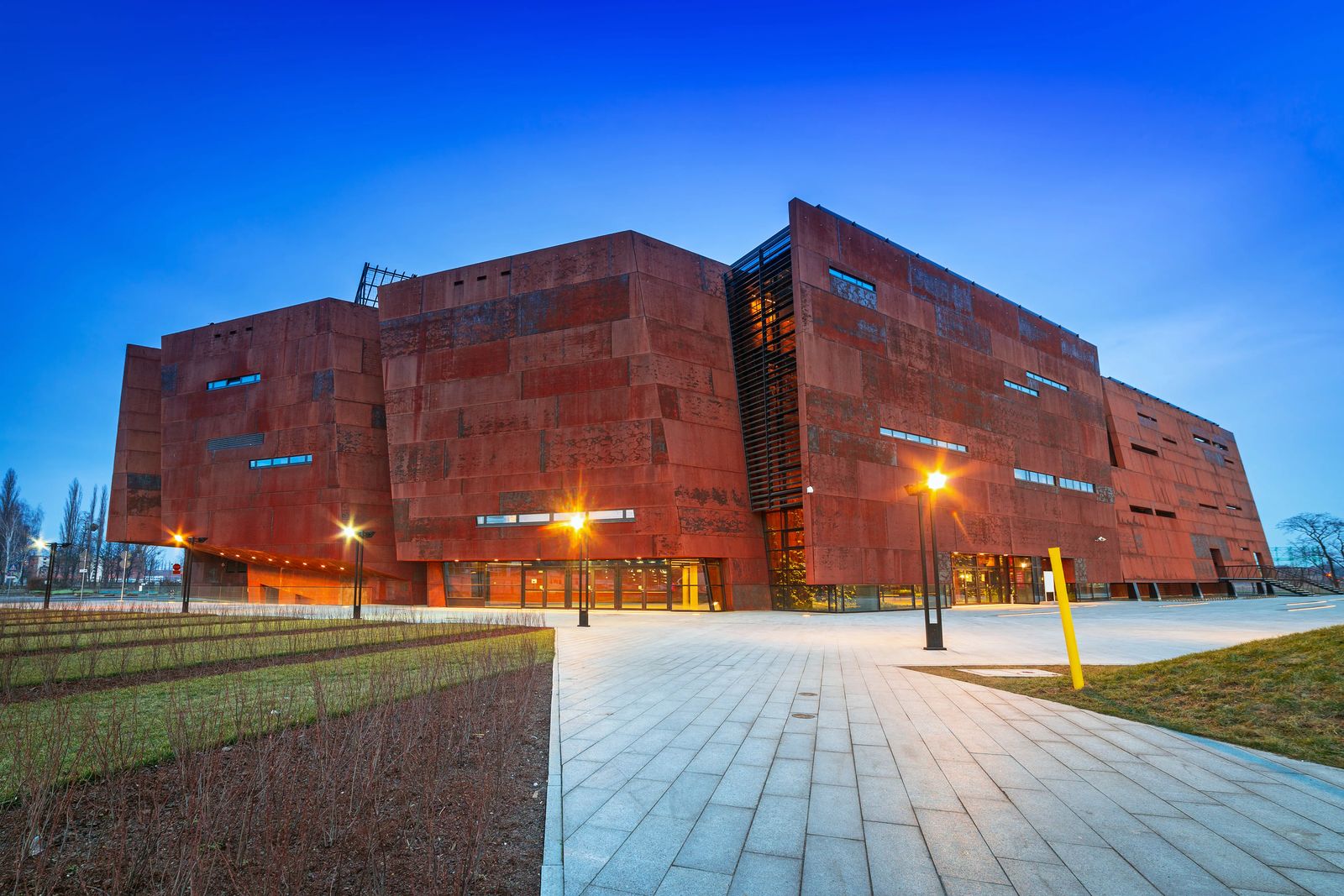
European Solidarity Center
Address: pI. Solidarności 1, 80-863 Gdańsk, Poland
I know my Culture Trekkers all like history, otherwise you would have clicked off this post awhile ago. This particular thing to see in Gdansk is just for you! It is surrounding the Solidarity Movement and round table talks that occurred after the Soviet Communism rule in Poland collapsed.
Because the Solidarity Movement was initiated by those Solidarity workers in the shipyard, the building itself resembles a great steel ship (if you look from the side). It captures the daily life, the essence of what it was for a Polish citizen to fight for democracy in their country after so many decades of being under oppressive rule. There are free audio guides available, and costs 20 PLN ($4.81) for an adult ticket. Be sure to check their visiting hours before going, and I suggest getting your ticket online to avoid the crowds.
It is within this very same courtyard that the events which led to the collapse of the Berlin Wall and the return of freedom across Europe began. There is a monument to the fallen shipyard workers to commemorate the events of December 1970 when communist regime opened fire against shipyard workers. If you look right next to the monument there is a gate into the former Lenin Shipyard which was the symbol of the Polish people against the Communist Regime.
Inside you will find the most important exhibit in the museum being the 21 strike postulates. These strike proposals were announced on August 17, 1980 and are also a part of the UNESCO list of the most valuable documents in history.
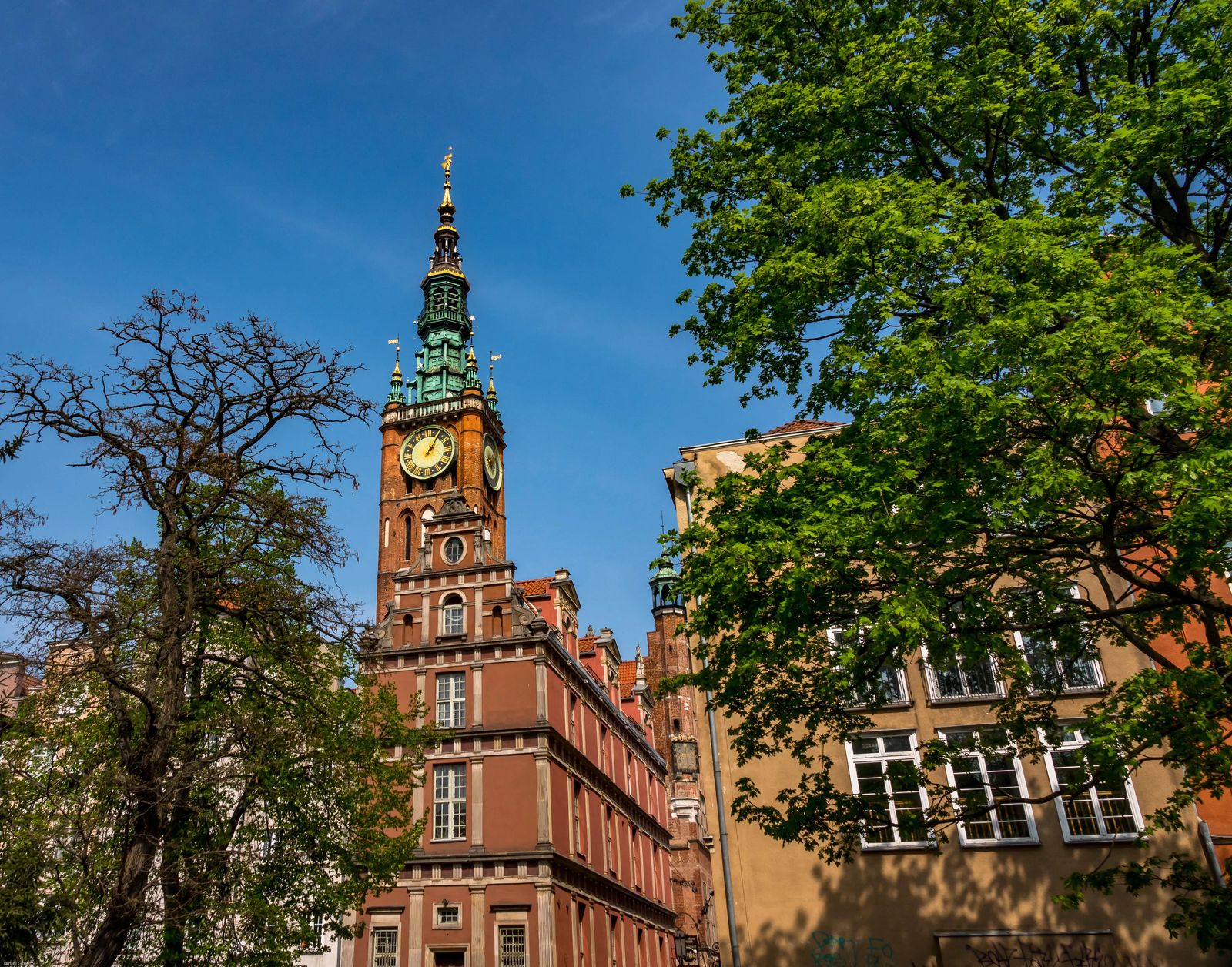
Gdansk Old City Hall (Ratusz)
Address: Ratusz Staromiejski, 33/35, Korzenna 33/35, 80-001 Gdańsk, Poland
Built in 1298 (initially) by Prince Wladyslaw Lokietek. Inside it was documented to hold merchant goods and assets and where law suits would be considered. It was also used as an asylum, as a church would be, to protect anyone seeking shelter. It survived the Teutoic order overtaking the city of Gdansk and survived up until 1336.
It has undergone several different renovations based on council needs, the Thirteen Years War. Knights swore oaths to the king here. It has burnt down , was rebuilt and a new tower added with bells. When Prussia occupied the area, the City Hall was changed again. A massive fire finally overtook the entire building in 1945. Finally the current gothic-renaissance layout was built in 1946 and was included in the post-war reconstruction and restoration of the city.
It is one of the most under-rated Gdansk attractions because most visitors just take a photo from the outside. I highly suggest sauntering into the Wielka Sala Rady room, or The Red Chamber. If you want to compare it to something in particular, I would compare it to the Doge's Palace in Venice.
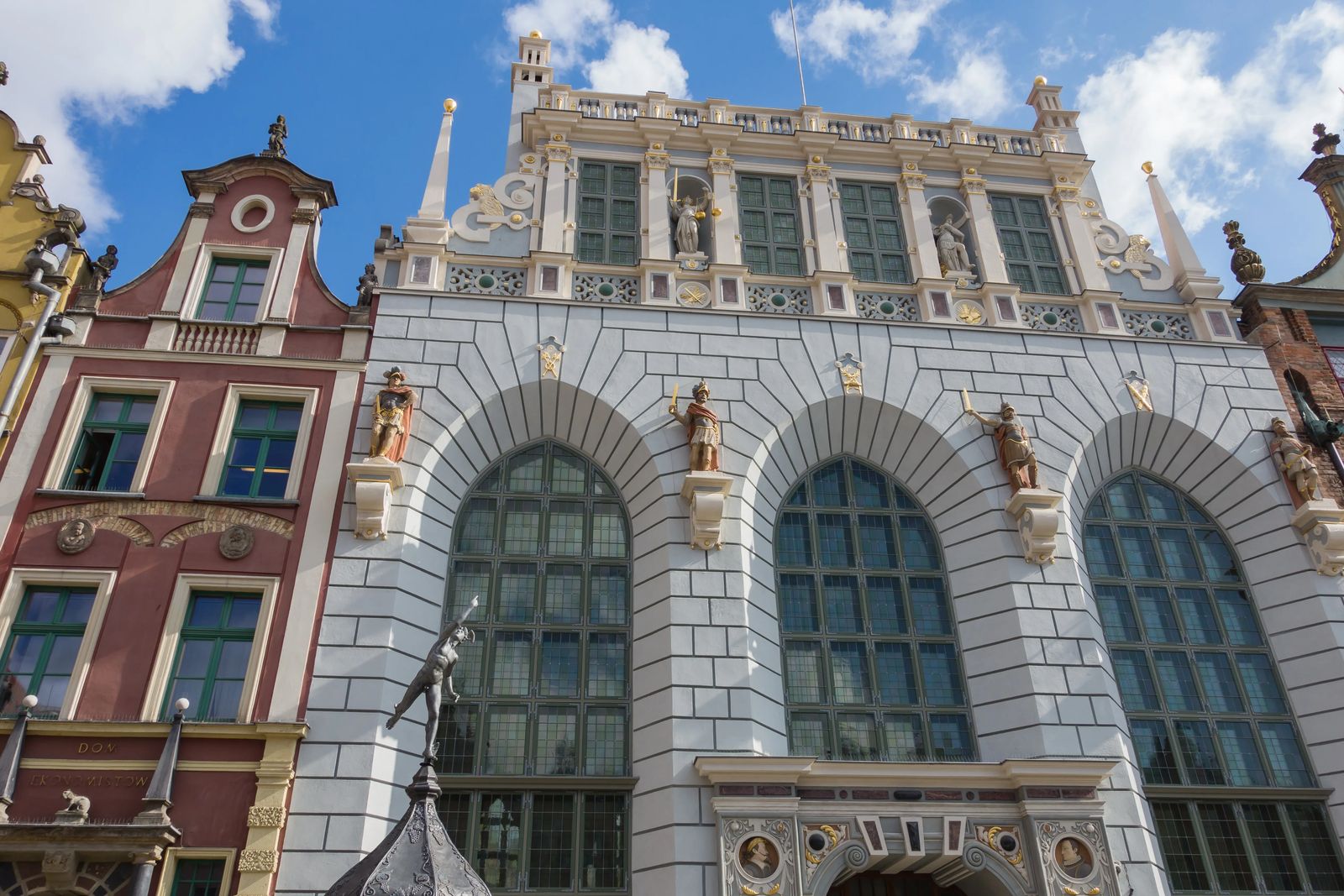
Artus Court
Address: Długi Targ 43-44, 80-831 Gdańsk, Poland
This began as a meeting place in the 15th-17th century, named after the story of King Arthur and the Knights of the Round Table. This majestic mansion was the seat of St George and the rich patricians. There were magicians, multi-day feasts, noble guests and courtly courtships in this building.
If you enter the building you are greeted by a 32 foot (10 m) tiled fireplace dating back to 1546. There are 500 tiles on this fireplace, it is flanked by Polish leaders, coats of arms, fantastical creatures. The gorgeous Gothic interiors and various other historical artifacts house in this building make it well worth the effort to visit.
It does require a ticket to enter but is only 10 PLN ($2.40) and is a great reprieve from the busy courtyard outside. It is right near Neptune Fountain so it is hard to miss.

The Great Armoury
Address: Kołodziejska, 80-980 Gdańsk, Poland
Built in the 16th century, this Great Armoury was used until the 1800's and puts on quite the display of Renaissance architecture. It is nearly all pink, and looks like it is a gingerbread house for Easter - despite my child-like description of this place, it truly is a masterpiece.
The well like structure in the front was used as an elevator to transport all the cannon balls and gunpowder to the basement. Now it is a fancy wine bar. I included this in things I would recommend seeing in Gdansk, because of the unique transformation that this building has undergone from the 17th century to now. This is the Great Armoury, a place that once housed the artillery Gdansk used to defend its walls and waterways. Why is it interesting? Because it is now used only for art exhibitions, including a lion that has his *undercarriage* and its cargo on display.
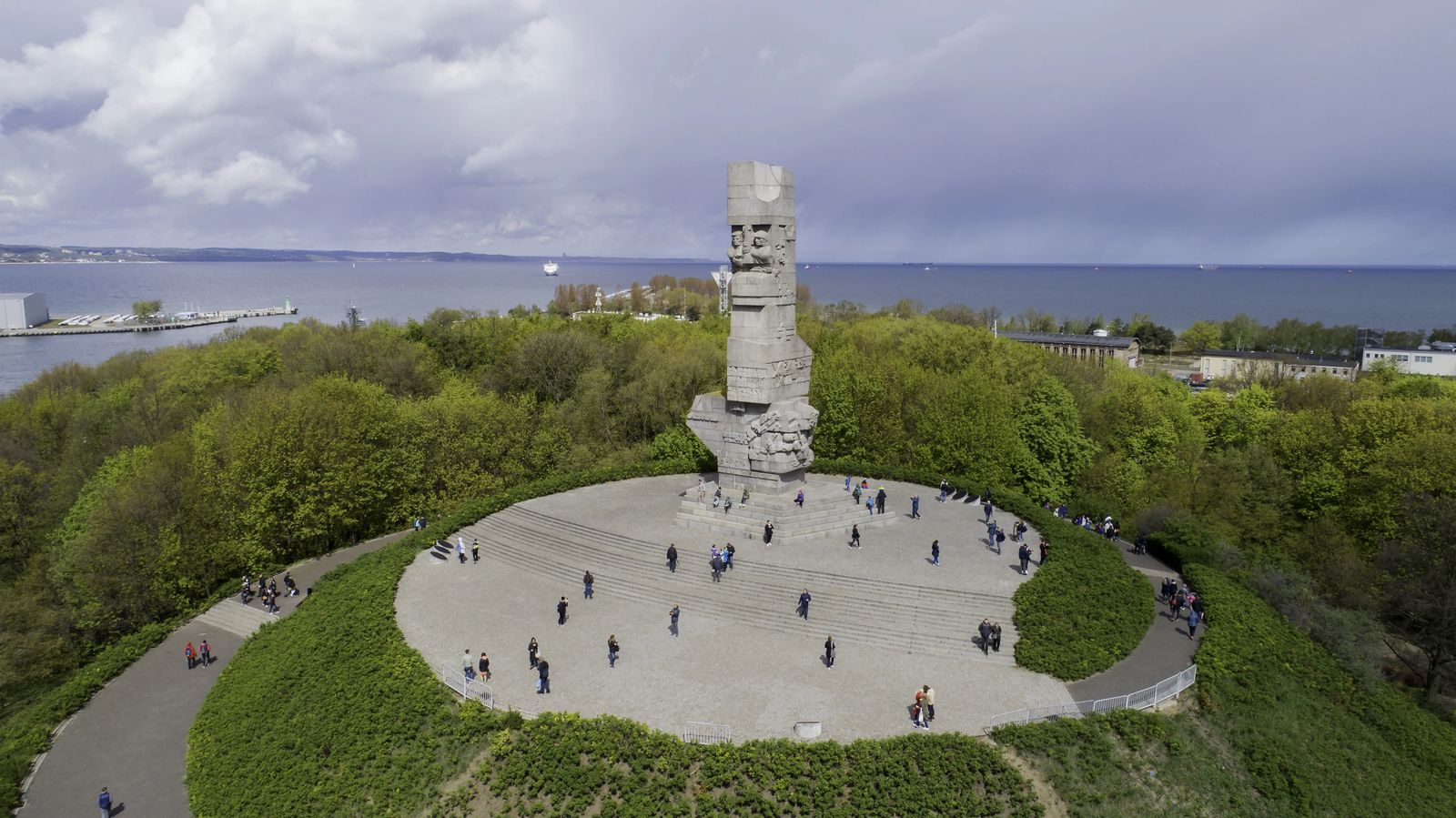
Westerplatte
Address: Westerplatte, 80-001 Gdańsk, Poland
This area is more than just a historical battlefield of World War II, it is a symbol of heroism, bravery, honor, and responsibility. This is the site of the first bomb attack of World War II. It is a memorial and memory to the Polish people of their Grandparents who chose to never give up.
It was 1939 when the German battleship SMS Schleswig-Holstein docked in the port next to the Polish Military Transit Depot on Westerplatte. The Polish Military had increased their troops to 210 by then. It was 4:48 AM and the Polish army was awakened with three cannons punching holes in their perimeter blowing up the oil warehouses.
Luckily the Polish Army had gained intelligence, fortified the island and the German Army walked right into an ambush surrounded by barbed wire and Polish defenders gunning them down. The Germans fought back ferociously with a machine gun trying to defend themselves, but the Poles destroyed the machine gun with a 76.2 mm field gun.
The Germans retaliated, took out the field gun, withdrew their troops, and dropped several bombs on the Polish (or attempted to). The Polish Army stood their ground, planted several land mines in between the trees of the island. The Germans surged again, but were decimated by the land mines and subsequent fires. They finally retreated around noon that day and Gdansk was safe, at least for a time.
The battle lasted until September 7th until at 945am the Poles surrendered because of lack of food, medical supplies, ammunition and fatigue. They had fought off tanks, bombers, German marine seiges, and so many more attempts at taking the island. In the end there were 300-400 dead Germans, and only one Polish defender had perished. The reinforcements never arrived to help hold the city of Gdansk, some historians believed the government wanted to let them be an enduring symbol of hope for the rest of the Poland. Their heroic memory still lives on today in this quite memorilzied battlefield that is a quite reprieve from the bustling city of Gdansk.
Be sure to visit these points of interest and image the scenario in your mind of the bravery of the Polish Defenders:
- Passenger ships marina.
- The shelter and observation tower.
- 'Fort' outpost.
- Tank T-34
- Cemetery of the Defenders- on the spot of non-existing Guardhouse No. 5.
- Guardhouse No. 1
- Ruins of New Barracks
- Remains of 'Non-commissioned officers' villa' - Guardhouse No. 3.
- A square in front the mould by candles.
- The mould - The Monument of the Defenders of the Coast
To get to Westerplatte, take a boat from Old Town located here. They depart every hour starting at 10am (check times for last boat departing) hours may vary by season. An adult ticket costs $10.81 USD (45 PLN) for a return ticket. Toilets may be sparse so be sure to use the facilities before going.
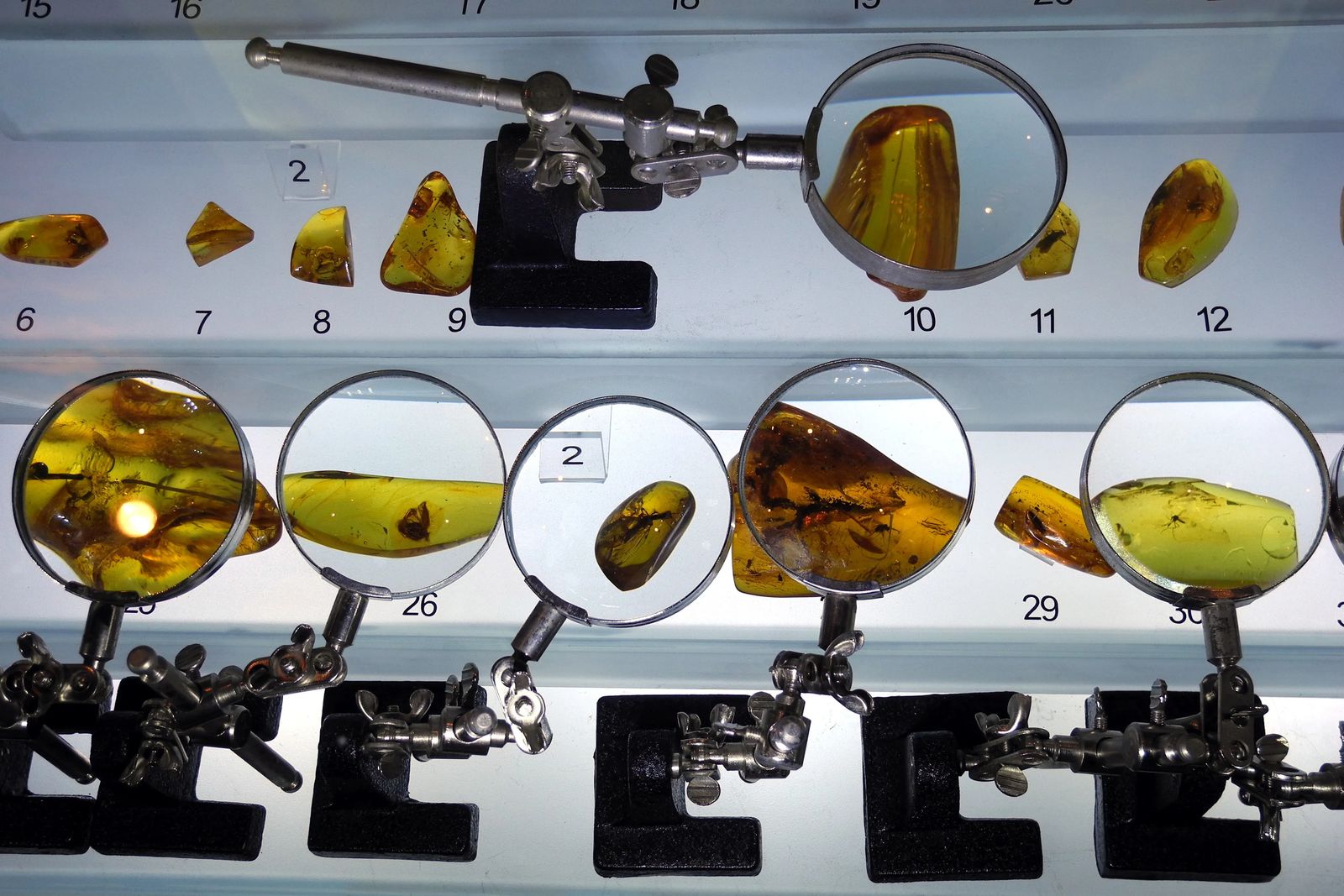
Amber Museum
Address: Targ Węglowy 26, 80-836 Gdańsk, Poland
Beyond the trapped mosquitos in Amber that I learned about in Jurassic Park, there are so many fascinating things about this resin I didn't know. Such as it takes 30 million years to make, the largest deposits are on the Baltic coasts, Amber from these regions were found in Egyptian tombs, and you can literally collect amber from walking on the beaches in Poland.
It is a very unique museum in that it doesn't just try to sell you jewelry made of Amber, but more tells a story of Amber throughout history. There are of course fossilized flora in Amber, tools used to extract the Amber, collections of modern and medieval items made of Amber, and last but not least a guitar and small ship made of Amber.
So if you like the unique, then include this on your things to see in Gdansk, then this should be on the top of your list.
A ticket in costs $2.87 (12 PLN) for an adult, but you can also visit on a Tuesday and it is free. It is quite a small museum (located inside the torture chamber and prison tower) so be prepared for a bit more crowded quarters.
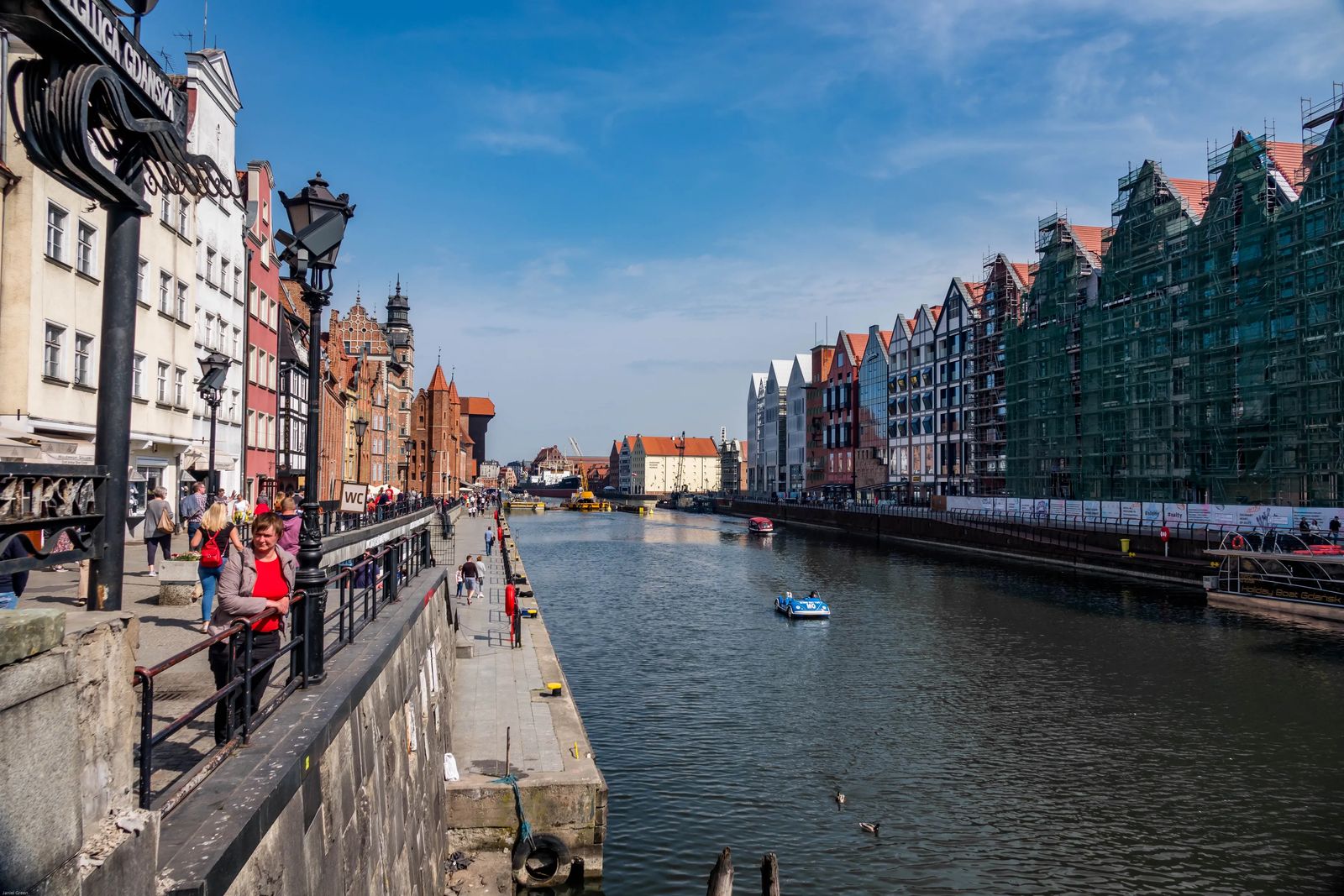
Dlugie Pobrzeze (Long Riverside)
Address: Długie Pobrzeże 5, 80-888 Gdańsk, Poland
This is the place to catch a little local nightlife in Gdansk, the Long Riverside, or Dlugie Pobrzeze. It runs along the Motlawa river and is filled with cafes, bars, restaurants and shops. You will see night cruises along the river set against a gorgeous sunset, and the famous water gates and bridges of the former shipyard.
If you arrive early, be sure to check out the Osrodek Kultury Morskiej, the largest Maritime Museum in Gdansk. I also highly recommend taking a food tour along this area, Poland has some pretty delicious traditional food ie/ Perogies!
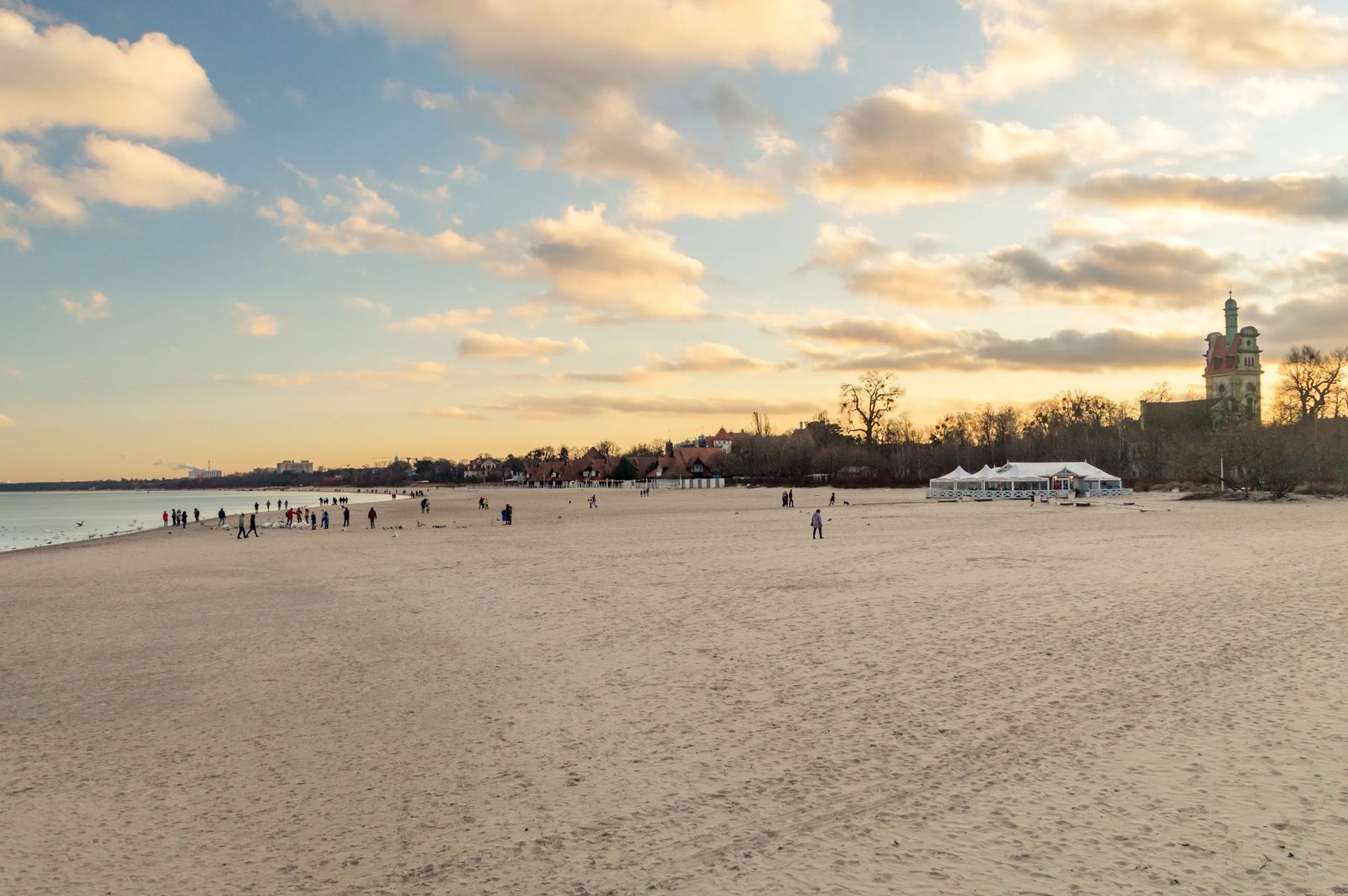
Jetty in Gdansk Brzezno
Address: Jelitkowo, Poland
Can you believe this beautiful beach was completely destroyed along with its pier from the 1900's during the German occupation? It has since been restored, with the pier going out 130 feet into the Baltic Sea. A picture perfect area and ideal Instagram spot for those visiting. It is even said that if you look carefully you might even find Amber stones washing up on shore that have been polished by the sea itself.
There are lifeguards here, and several restaurants and bars that you can buy some food from in order to use the restroom. Stogi Beach is also another option that is both clean and safe for beach lovers to visit as well.
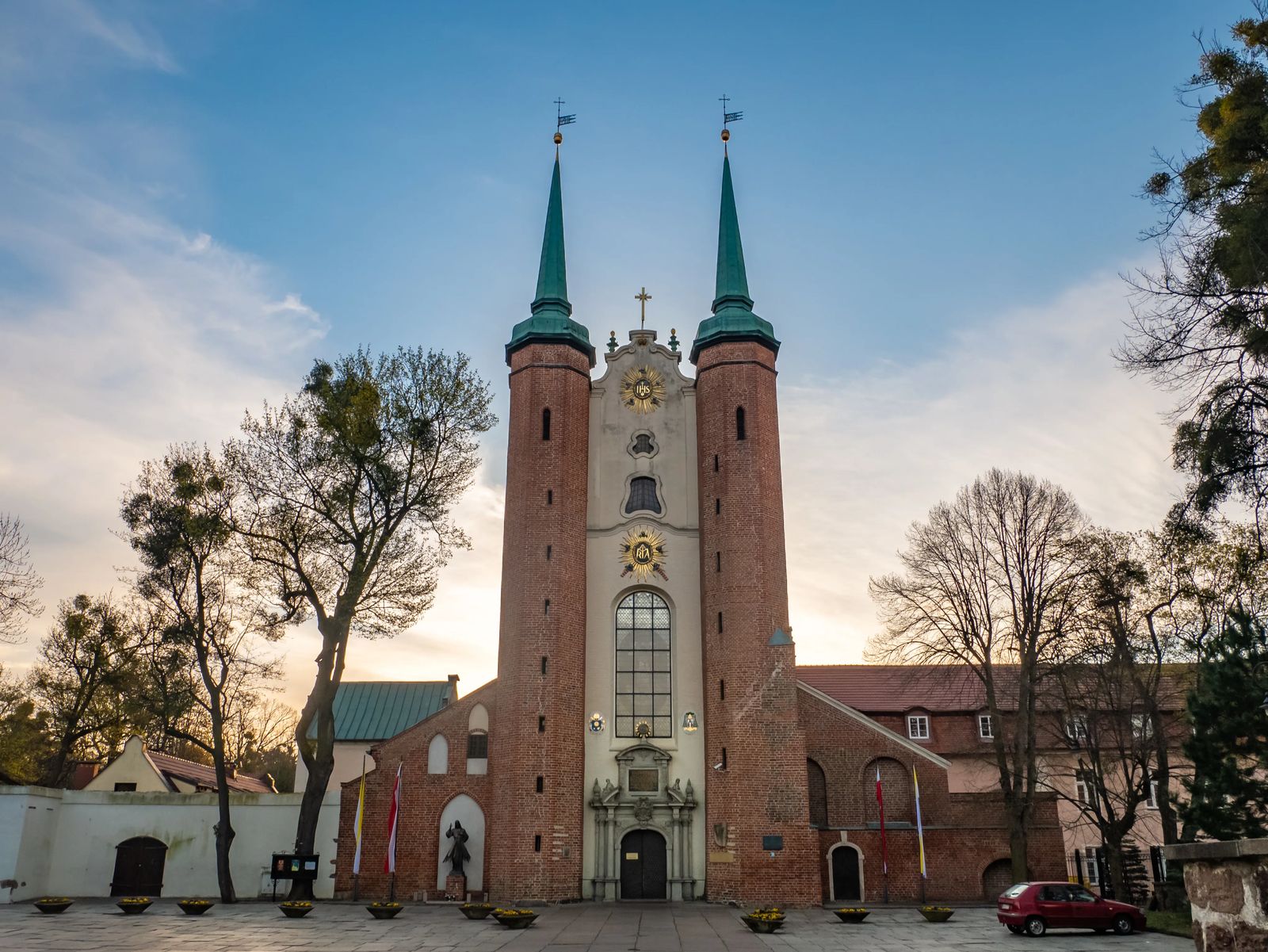
Oliwa Cathedral
Address: Cystersów 17, 80-300 Gdańsk, Poland
This gorgeous cathedral was founded in the 13th century by Cistercian monks. Its 107-metre long interior makes it the longest medieval church in Poland. When you walk in, the stark contrast of white walls against the dark paintings and adornments makes it appear as if the interior is going to battle with the devil himself. It is the gothic arches lined with stars at each wooden juncture and the angel heralds on the organ that truly made me fall in love with this beautiful building.
The world-famous Rococo organ was designed by Johann Wilhelm Wuff in 1788. Today there are more than 6,000 pipes, and when a certain mechanism is triggered the angels adorning the organ start ringing bells and trumpeting their horns from heaven. Make sure you linger longer to hear the demonstrations of the organ - it truly is a slice of heaven soothing your soul to witness something so majestic.
It is free to enter, but opening times vary so be sure to check their website for closing times for masses and opening times for visitors. Please note the Archdiocesan Museum is only open from July 1 - Sept 15th.

Karuzela Gdańska (Merry-Go-Round)
Address: Targ Rybny, 80-001 Gdańsk, Poland
Who doesn't love a merry-go-round?! It is a perfect activity for kids, and for those who want to feel a bit of Mary Poppins in their life. This gorgeous 17th century Venetian inspired Merry Go Round is 39 ft (12 m) diameter, and can seat up to 78 people. If you look closely you can see important elements of Gdansk throughout the Karuzela Gdanska. On the top you will see St. Mary's Basilica, Długa Street with the Main Town Hall, Żuraw, sea shore.
For about $2.37(10 PLN) you get a 3-minute ride around, on very well behaved horses. Speaking of Mary Poppins, they also play DISNEY MUSIC! Who doesn't love Disney! To make this even cheaper, bring your tourist card for a 10% discount. It is open
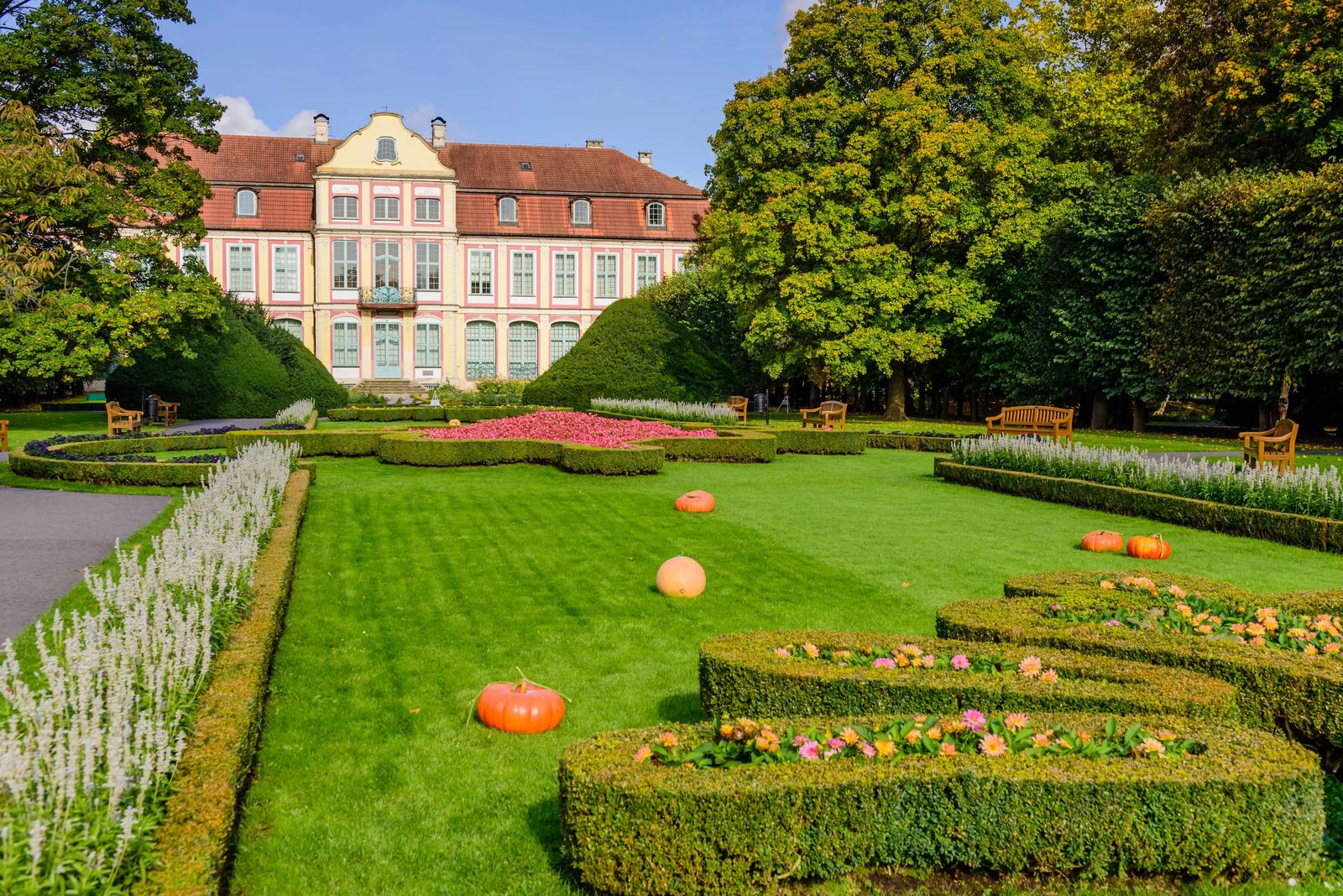
Oliwa park & Abbey Palace
Address: Opata Jacka Rybińskiego, 80-001 Gdańsk, Poland
If you need to get away from all the tourists, really soak in the beauty of Poland yet still feel like you aren't wasting your precious vacation time - Oliwa Park and Abbey are the place to go. This serene park is perfectly manicured with gorgeous full grown trees, medieval like flower beds lined with bushes, and even had a pond with ducks and swans.
It was originally developed by the Cistercians from the Abbey. It started out as a humble vegetable garden, and grew into a magnificent place of peaceful contemplation. That was, until the plague hit in the early 17th century. Compared to the rest of Europe, it was quite late for the plague to arrive here, mostly because of the secluded nature of Poland.
Because there was no cure, and nearly 50% of Europe died from the plague, many turned to monks and religion as a way to save themselves. So if you look at the main gate of the convent, this was actually used as a Dom Zarazy or Plague House. Part of this convent was used to house those infected with the Plague, kind of creepy to think about. I personally wondered if there were any hauntings that happened here.
Now it is used as the seat of the Modern Art Department of the National Museum of Gdansk. There are exhibits here of Polish artists from the 19th and 20th centuries.

Gradowa Gora hill
Address: Gradowa, 80-001 Gdańsk, Poland
Living in Utah makes me a bit spoiled with our towering 13,534 ft (4125 m)Kings Peak. So when I heard that this hill was only 150 feet (46m) tall, it made me feel a bit let down to be honest. I went anyway and was glad I did, because it gave some pretty spectacular views of Gdansk.
The walk up is not very demanding, and there is even a fortress and millenary cross at the top. The view is free, and the hill itself is open 24 hours :)
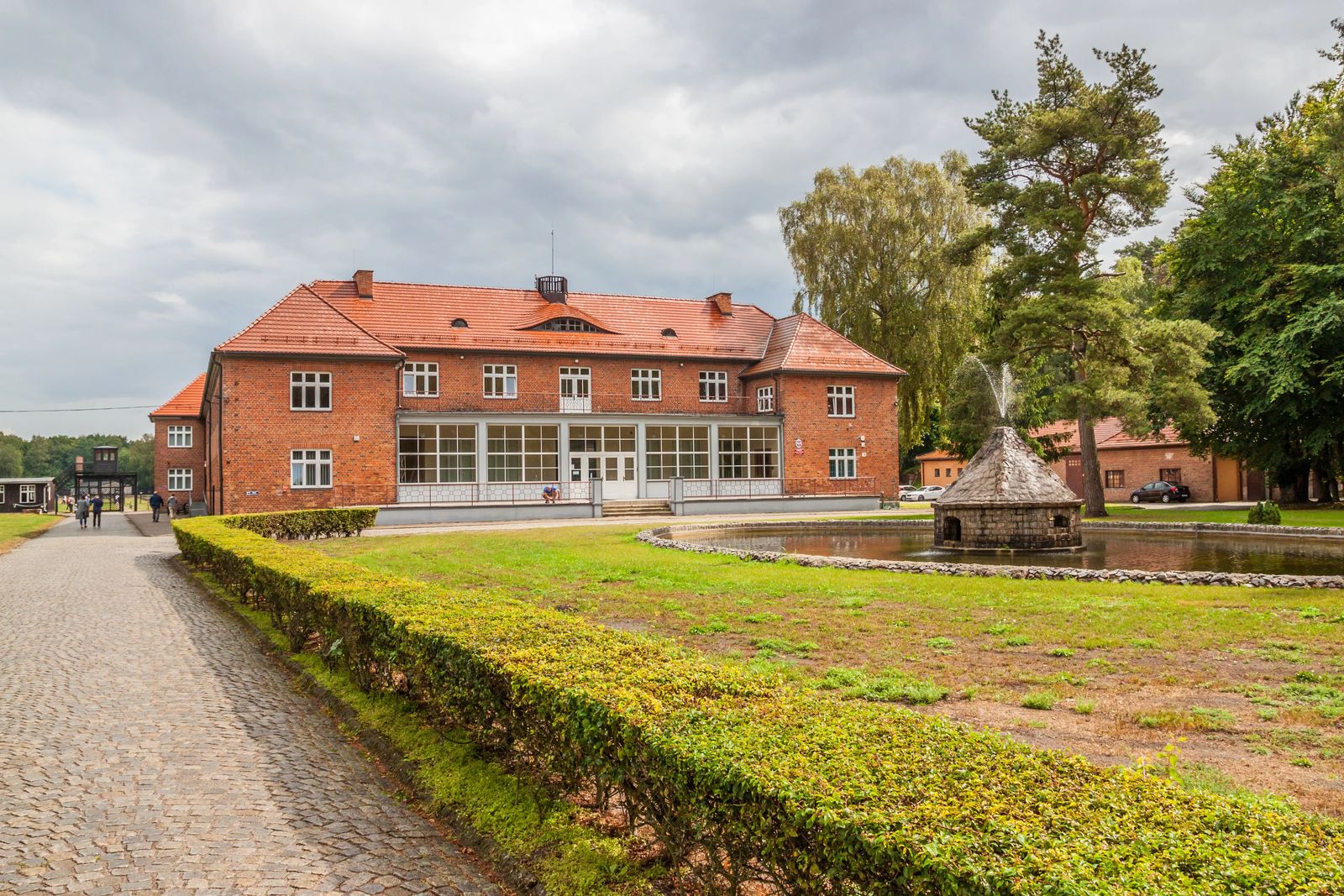
Stutthof concentration camp
Address: Ul. Muzealna, Sztutowo 82-110 Poland
This camp was originally a camp for the political enemies of the Nazi regime. These 'political enemies' consisted of Polish intelligence officers, prisoners of war, Jehovah's witnesses and many more. It only took two weeks for them to fill the camp with more than 6,000 prisoners.
Through the course of the war there were 30 buildings, a crematorium, gas chamber, and torture chamber as well. For the 25 buildings used to house prisoners, there were 25,000 prisoners. Each building for the prisoners was the size of a duplex apartment. Imagine cramming 1,000 prisoners into each of those. No surprisingly Typhus broke out in the camp killing many prisoners, along with the gas chamber which killed 150 prisoners at a time. The most brutal way to kill the prisoners, was by death march, in snow, with minimal to no food. At Stutthof, 26,000 people lost their lives. It was the last major concentration camp in Poland to be liberated. It is estimated that 65,000 people here lost their lives over the course of Stutthof being operational.
The museum is open daily, and is free to enter. There is a historical film with English subtitles available but does cost $1.19 (5 PLN) so be sure to bring some cash in local currency to view this. There are buses that go straight from Gdansk to the concentration camp, parking is available as well.
Map of Thing To See In Gdansk
Public transportation
There are buses available in Gdansk, and is serviced by EURail as well. Be sure to check out my how to train travel in Europe video, if it is your first time using trains.
For the fastest and cheapest way to get to the center of Gdansk or any locations mentioned here, I highly suggest using Rome2Rio. It is honestly my 'go to' transportation buddy, and no I'm not an affiliate with them, I just genuinely find them useful while traveling.
If you are planning on staying in Gdansk for awhile to explore the coast, then I would highly suggest renting a car so you can visit Sopot and Gdynia as well. All very beautiful cities in Poland, each with their own unique history.
Is Gdansk expensive?
If you are using USD, then this will be the cheapest vacation you will take in Europe. You can have a full four course meal, with an adult beverage and a generous tip all for $11-$20 (50-84 PLN)
Just don't take taxis in any major thoroughfare. Find the taxi driver reading the paper three or four blocks over and the price will drop from an expected $75 (which they will claim is because of a national holiday), to $15 to go across to the other side of the city. Just use your google translate on your phone so they know you aren't messing around. This is also why I use Rome2Rio, so that I can price check them if they try to take advantage of me.
Save Money in Gdansk
If the exchange rate from USD to zl or PLN is not enticing enough for you, there are definitely other ways you can save money. Get the Gdansk City Card, you will get 20% discount at some restaurants, as well as discounts or free admissions to various museums. Public transport also becomes free through Sopot, Gdynia, and Gdansk. Just make sure it is still valid after the sun goes down.
Most museums are free on Tuesdays, for my fellow backpackers, so plan your trip accordingly. It Is possible to see it all in one day, but you will virtually be taking a photo and racing to the next area. I recommend allowing yourself at bare minimum, 3 days to visit the city properly and take your time.
Like it? Pin it! Sharing is Caring!
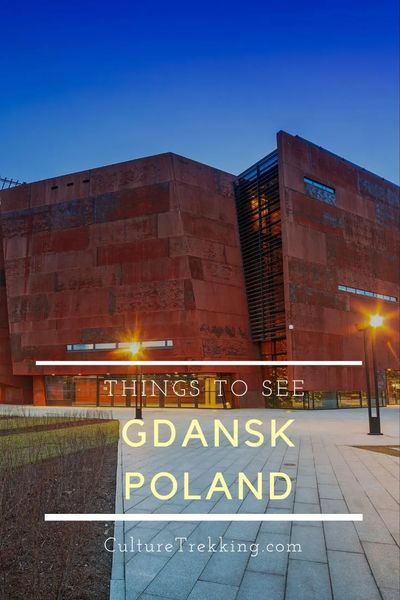.jpg?fit=outside&w=1600)
.jpg?fit=outside&w=1600)
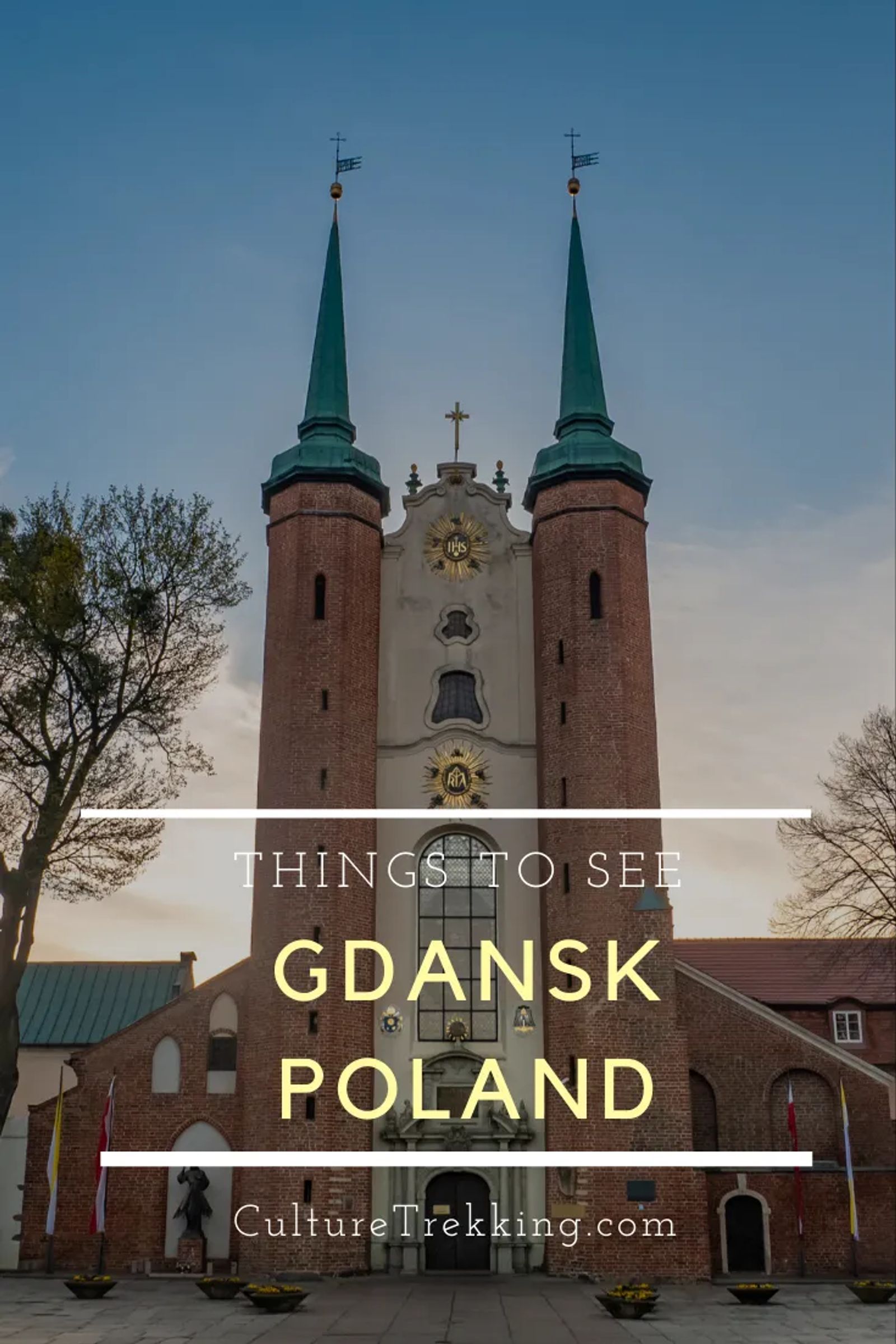
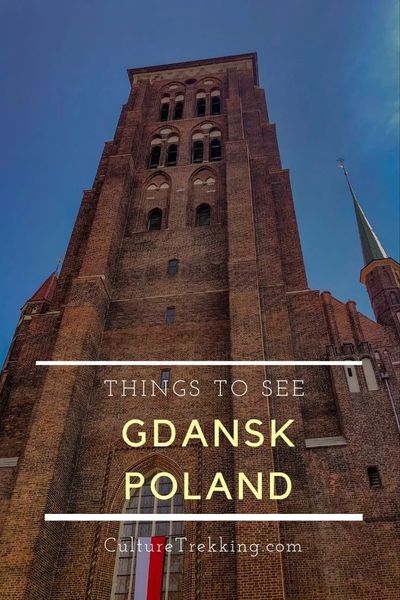.jpg?fit=outside&w=1600)
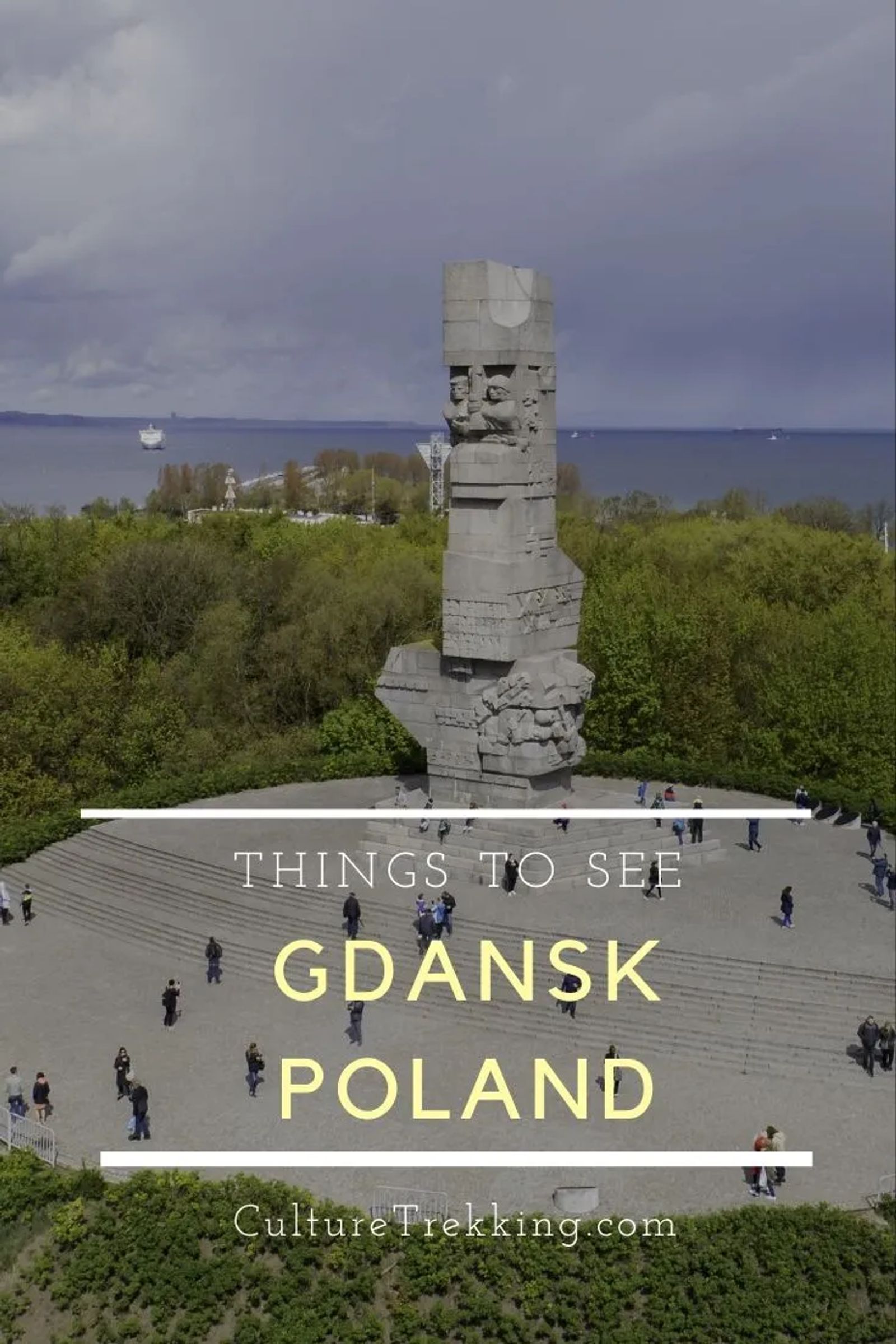
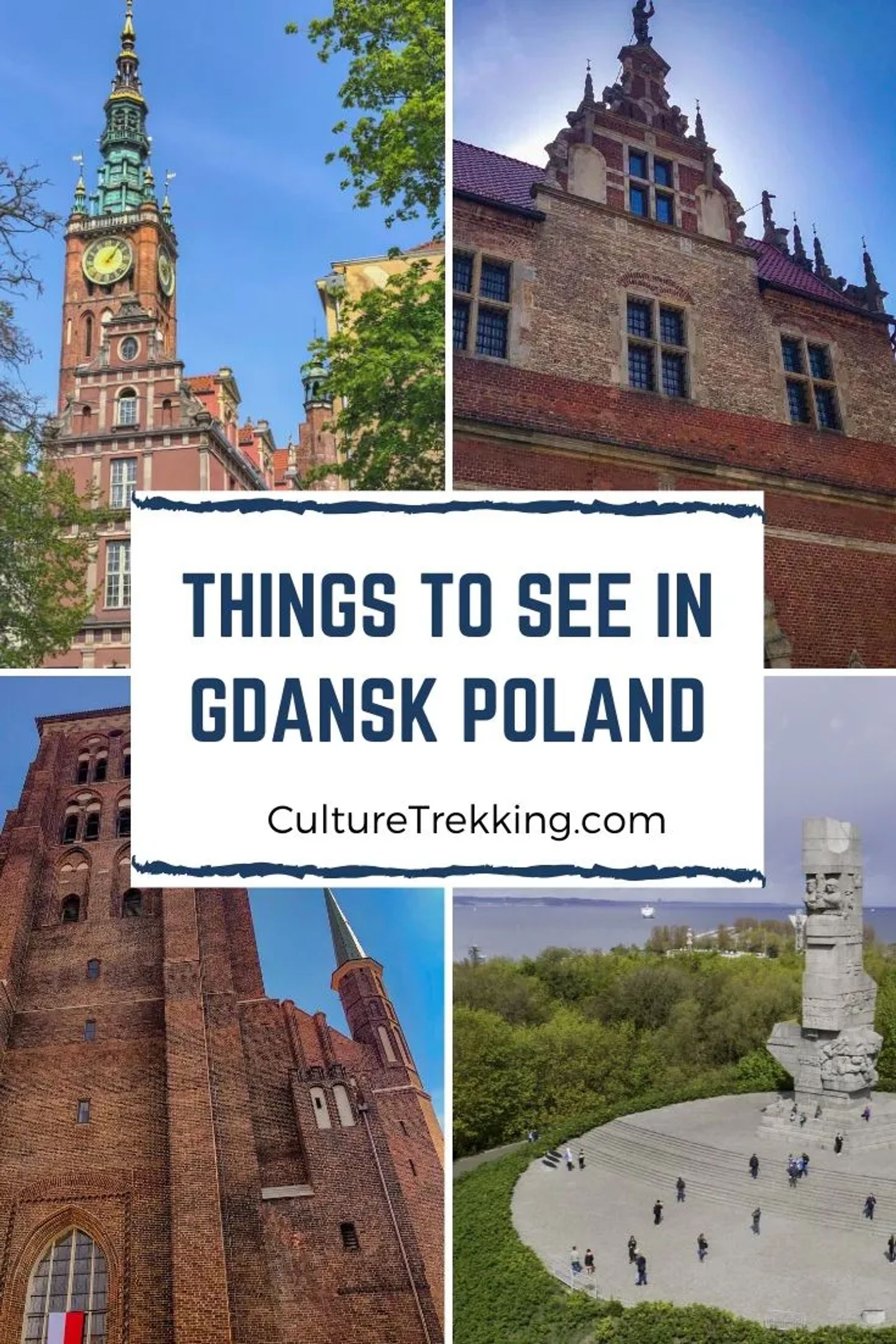
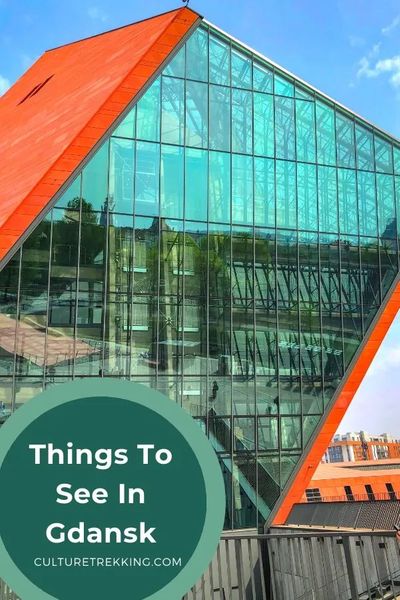.jpg?fit=outside&w=1600)
Where to Stay in Gdansk
More Adventures In Poland
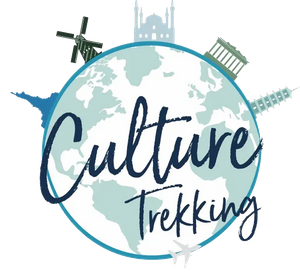

Welcome to Culture Trekking!
My name is Janiel, a leader in the travel industry with over 20+ years of experience with international travel. I specialize in solo female travel, cultural connections, sustainable adventures, food and history to help make your travel experiences fun, meaningful, and delicious. My experience in travel, and my personal story have allowed me to get published in Fodor's Travel, Atlas Obscura, Metro.co.uk, Trip Advisor, and multiple Podcast interviews. You can find me on pretty much every social media channel YouTube, Instagram, Twitter, Facebook, Pinterest, TikTok. To read more about me and my story click here. If you are a brand and would like to work with me, click here.







